Psion 7527CBTRA2041M Workabout Pro G2 User Manual 7535 G2 Hand Held Computer
Psion Inc Workabout Pro G2 7535 G2 Hand Held Computer
Psion >
Contents
- 1. Users manual 7527C
- 2. Revised users manual part 1
- 3. Revised users manual part 2
- 4. Revised user manual part 3
Revised users manual part 1
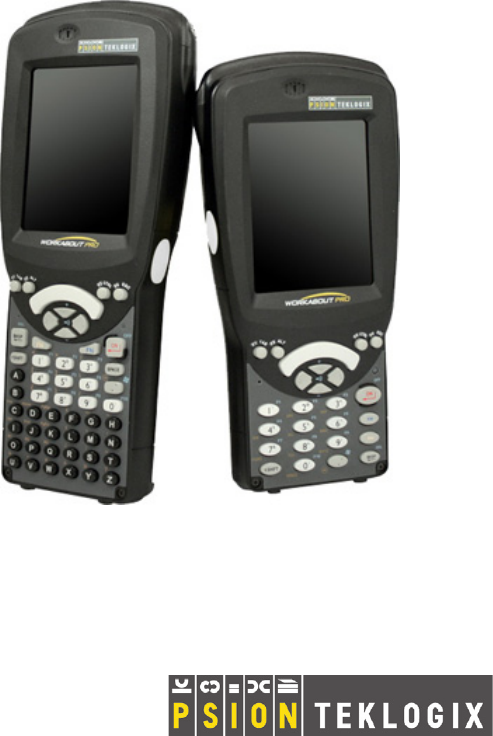
ISO 9001 Certified
Quality Management System
WORKABOUT PRO
(Model Numbers 7527 C G2 & 7527 S G2)
Hand-Held Computer With
Windows CE 5.0
User Manual
June 15, 2007 Part No. 8100140.A
© Copyright 2007 by Psion Teklogix Inc., Mississauga, Ontario
This document and the information it contains is the property of Psion Teklogix Inc.,
is issued in strict confidence, and is not to be reproduced or copied, in whole or in
part, except for the sole purpose of promoting the sale of Psion Teklogix manufac-
tured goods and services. Furthermore, this document is not to be used as a basis for
design, manufacture, or sub-contract, or in any manner detrimental to the interests
of Psion Teklogix Inc.
Windows® and the Windows Logo are trademarks or registered trademarks of
Microsoft Corporation in the United States and/or other countries.
The Bluetooth® word mark and logos are registered trademarks owned by
Bluetooth SIG, Inc. and any use of such trademarks by Psion Teklogix Inc. is
under license.
All trademarks are the property of their respective holders.

WORKABOUT PRO G2 Hand-Held With Windows CE 5.0 User Manual i
TABLE OF CONTENTS
Chapter 1: Introduction
1.1 About This Manual ............................ 3
1.2 Text Conventions............................. 4
1.3 WORKABOUT PRO Features...................... 4
1.3.1 The WORKABOUT PRO C Hand-Held............. 6
1.3.2 The WORKABOUT PRO S Hand-Held.............7
Chapter 2: Basic Checkout
2.1 Preparing The WORKABOUT PRO For Operation...........11
2.1.1 The Main Battery.........................11
2.1.1.1 Charging The Main Battery...............11
2.1.2 The Backup Battery . .......................12
2.2 Turning The WORKABOUT PRO On And Off.............12
2.2.1 Installing The Battery And Switching The Unit On........12
2.2.2 Switching The Unit Off (Suspend)................13
2.3 Calibrating The Touchscreen.......................13
2.4 Configuring The Summit RA2041 802.11b/g ..............13
2.4.1 Summit Client Utility (SCU) For Model RA2041 ........14
2.4.2 Assigning The IP Address.....................14
2.4.3 Name Servers Tab.........................16
2.4.4 Using The SCU To Connect To The WLAN . ..........17
2.4.4.1 SSID...........................18
2.4.4.2 EAP Type........................18
2.4.4.3 Encryption........................18
2.5 Checking The Scanner ..........................19
2.6 Data Transfer Between The PC & The Hand-Held............20
2.6.1 Using Microsoft® ActiveSync® .................20
2.6.2 Using Microsoft® Vista®.....................20
Contents
ii WORKABOUT PRO G2 Hand-Held With Windows CE 5.0 User Manu
1
2.8 Resetting The Hand-Held........................ 26
2.8.1 Performing A Warm Reset.................... 26
2.8.2 Performing A Cold Reset..................... 27
2.8.2.1 Cold Resetting To The BooSt Menu.......... 27
2.8.2.2 Cold Resetting To The Windows 5.0 OS. . ...... 27
Chapter 3: Getting To Know Your WORKABOUT PRO
3.1 Features Of The WORKABOUT PRO................. 31
3.2 The Battery................................33
3.2.1 Battery Safety .......................... 33
3.2.2 Removing The Battery Pack...................33
3.2.2.1 Battery Swap Time...................33
3.2.3 Charging The Battery ...................... 34
3.2.3.1 Chargers And Docking Stations............34
3.3 Switching The Hand-Held On And Off................. 35
3.4 The Keyboard .............................. 36
3.4.1 Modifier Keys..........................36
3.4.1.1 Activating Modifier Keys............... 37
3.4.1.2 Locking Modifier Keys................. 37
3.4.2 The Keys............................. 37
3.4.3 Function Keys And Macro Keys.................38
3.4.3.1 Function Keys.....................38
3.4.3.2 Macro Keys (WORKABOUT PRO C Only) ..... 39
3.4.4 52-Key Keyboard – Accessing Alpha Keys ........... 39
3.4.5 25-Key Keyboard – Accessing Alphanumeric Keys. ...... 39
3.4.6 The Keypad Backlight...................... 41
3.5 The Display............................... 41
3.5.1 Adjusting The Display Backlight ................41
3.5.2 Calibrating The Touchscreen...................41
3.6 WORKABOUT PRO Indicators..................... 43
3.6.1 LED................................ 43
3.6.3 Onscreen Indicators ....................... 44
WORKABOUT PRO G2 Hand-Held With Windows CE 5.0 User Manual iii
Contents
3.7 Monitoring The Battery And Maximizing Run Time...........47
3.7.1 Storing Batteries..........................47
3.9 Bluetooth Radio..............................48
3.9.1 Pairing A Bluetooth Headset Or Other Bluetooth Device.....49
3.10Inserting The SD/MMC Card And SIM Card ..............49
3.10.1Inserting The Card.........................49
3.11 General Maintenance...........................50
3.11.1Caring For The Touchscreen ...................50
3.11.2Cleaning The WORKABOUT PRO................50
Chapter 4: Working With Windows CE 5.0
4.1 Navigating In Windows CE 5.0 ......................55
4.1.1 Navigating Using A Touchscreen And Stylus...........55
4.1.2 Navigating Using The Keyboard . ................55
4.2 Working With Files, Folders And Programs...............56
4.3 The Startup Desktop............................57
4.3.1 The Desktop Icons.........................58
4.3.2 The Taskbar............................59
4.3.2.1 Using The Taskbar....................59
4.3.2.2 Customizing The Taskbar................60
4.4 The Start Menu..............................62
4.4.1 The Desktop............................63
4.4.2 Security Settings..........................63
4.4.3 Programs..............................65
4.4.4 Shortcuts..............................67
4.4.5 Settings...............................69
4.4.6 Run.................................70
4.4.7 Shutdown .............................70
4.5 Using A Dialog Box............................71
Chapter 5: Configuration
5.1 Remote Connect. .............................79
5.2 The TekTerm Application.........................79
5.3 The Control Panel.............................79
5.4 Control Panel Icons............................80
Contents
iv WORKABOUT PRO G2 Hand-Held With Windows CE 5.0 User Manual
5.5 Basic Setup................................ 84
5.5.1 Display Properties........................ 84
5.5.1.1 Display Backlight ................... 85
5.5.1.2 Display Appearance..................86
5.5.2 Keyboard Properties ....................... 87
5.5.2.1 Key Repeat....................... 87
5.5.2.2 Keyboard Backlight .................. 88
5.5.2.3 Keyboard One Shot Modes. . . ............ 89
5.5.2.4 Keyboard Macro Keys ................. 90
5.5.2.5 Unicode Mapping ...................92
5.5.2.6 Scancode Remapping ................. 93
5.5.3 Volume And Sound Properties.................. 96
5.5.3.1 Volume Adjustments.................. 97
5.5.3.2 Sound Adjustments................... 97
5.5.4 Power Management Properties.................. 98
5.5.4.1 Battery Capacity.................... 98
5.5.4.2 Power Saving Suspend.................99
5.5.4.3 Suspend Threshold...................100
5.5.4.4 Advanced........................101
5.5.4.5 Devices.........................102
5.5.4.6 Wakeup.........................102
5.5.5 Stylus Properties.........................103
5.5.5.1 Double-Tap.......................103
5.5.5.2 Calibration.......................103
5.5.5.3 Touch..........................104
5.5.6 Manage Triggers.........................104
5.5.6.1 Trigger Mappings ...................105
5.5.6.2 Add And Edit Trigger Mapping............106
5.5.7 Certificate Assignment......................108
5.6 Bluetooth Setup.............................109
5.6.1 The Devices Tab.........................110
5.6.1.1 Pairing A Device....................111
5.6.2 The Servers Tab.........................114
5.6.3 Outgoing Tab...........................115
5.6.4 Active Conn. Tab.........................116
5.6.5 The Properties Tab........................117
5.6.6 The Bluetooth GPRS WAN Connection . ............117
5.7 Total Recall ...............................123
5.7.1 Creating A Backup Profile....................124
WORKABOUT PRO G2 Hand-Held With Windows CE 5.0 User Manual v
Contents
5.7.2 Restoring A Profile .......................128
5.8 The Storage Manager..........................128
5.8.1 Formatting A Memory Card...................128
5.8.2 Creating Partitions........................129
5.8.3 Partition Management......................131
5.9 IPv6 Support. . . ............................133
5.10Scanner Settings.............................134
5.10.1Bar Codes............................135
5.10.1.1 Scanner.........................135
5.10.1.2 Restoring Default Settings...............135
5.10.2Decoded (Internal) Scanners...................137
5.10.2.1 Options.........................137
5.10.2.2 Decoded (Internal) Advanced Options........138
5.10.2.3 Decoded (Internal) 2D Scanning Options.......139
5.10.2.4 Decoded (Internal) Data Options...........140
5.10.2.5 Code 39........................141
5.10.2.6 Code 128........................144
5.10.2.7 EAN 13 ........................144
5.10.2.8 EAN 8.........................145
5.10.2.9 UPC A.........................145
5.10.2.10UPC E.........................146
5.10.2.11UPC/EAN Shared Settings ..............147
5.10.2.12Code 93........................148
5.10.2.13Codabar........................149
5.10.2.14MSI Plessey......................149
5.10.2.15Interleaved 2 of 5 ...................150
5.10.2.16Discrete 2 of 5.....................151
5.10.2.17RSS Code.......................152
5.10.2.18Composite.......................152
5.10.2.19PDF-417........................153
5.10.2.20Micro PDF-417....................153
5.10.3Decoded (HHP).........................154
5.10.3.1 Decoded (HHP) Scanner Options...........154
5.10.3.2 Decoded (HHP) Advanced Options..........154
5.10.3.3 Code 39........................155
5.10.3.4 Trioptic Code .....................156
5.10.3.5 Code 128........................156
5.10.3.6 EAN 13 Settings....................157
5.10.3.7 EAN 8.........................158
5.10.3.8 UPC A Settings....................158
Contents
vi WORKABOUT PRO G2 Hand-Held With Windows CE 5.0 User Manual
5.10.3.9 UPC E Settings.....................159
5.10.3.10UPC/EAN Shared Settings...............160
5.10.3.11Code 93.........................160
5.10.3.12Codabar.........................161
5.10.3.13MSI Plessey ......................162
5.10.3.14Code 11.........................163
5.10.3.15Interleaved 2 of 5....................163
5.10.3.16Matrix 2 of 5......................164
5.10.3.17IATA 2 of 5.......................164
5.10.3.18Discrete 2 of 5.....................165
5.10.3.19Telepen.........................165
5.10.3.20 RSS Code (Reduced Space Symbology). . ......166
5.10.3.21 PosiCode (Reduced Space Symbology) . . ......167
5.10.3.22Composite.......................167
5.10.3.23TLC-39.........................168
5.10.3.24PDF-417........................168
5.10.3.25Micro PDF-417.....................169
5.10.3.26Code 16K........................169
5.10.3.27Code 49.........................170
5.10.3.28Codablock.......................170
5.10.3.292D Data Matrix.....................170
5.10.3.302D QR Code......................171
5.10.3.312D Maxicode......................171
5.10.3.322D Aztec........................172
5.10.3.33Postal: PlaNET.....................172
5.10.3.34Postal: PostNET....................172
5.10.3.35Postal: Australian....................173
5.10.3.36Postal: Canadian....................173
5.10.3.37Postal: China......................173
5.10.3.38Postal: Japanese ....................173
5.10.3.39Postal: Kix.......................174
5.10.3.40Postal: Korean.....................174
5.10.3.41Postal: Royal......................174
5.10.4Decoded (Intermec ISCP)....................175
5.10.4.1 Decoded (Intermec ISCP) Options...........175
5.10.4.2 Decoded (Intermec ISCP) Advanced Options.....175
5.10.4.3 Code 39.........................176
5.10.4.4 Code 128........................178
5.10.4.5 EAN 13 Settings....................179
5.10.4.6 EAN 8 .........................180
5.10.4.7 UPC A Settings.....................180
WORKABOUT PRO G2 Hand-Held With Windows CE 5.0 User Manual vii
Contents
5.10.4.8 UPC E Settings ....................181
5.10.4.9 UPC/EAN Shared Settings ..............181
5.10.4.10Code 93........................182
5.10.4.11Codabar........................183
5.10.4.12MSI Plessey......................184
5.10.4.13Code 11 ........................185
5.10.4.14Interleaved 2 of 5 ...................185
5.10.4.15Matrix 2 of 5......................186
5.10.4.16Discrete 2 of 5.....................186
5.10.4.17Telepen.........................187
5.10.4.18 RSS Code (Reduced Space Symbology) .......188
5.10.4.19PDF-417........................188
5.10.4.20Micro PDF-417....................189
5.10.4.21Codablock.......................189
5.10.5Imager..............................190
5.10.5.1 Imager Options ....................190
5.10.5.2 Imager Advanced Options...............191
5.10.5.3 Code 39 Settings....................194
5.10.5.4 Code 128 Settings ...................194
5.10.5.5 EAN 13 ........................194
5.10.5.6 EAN 8.........................195
5.10.5.7 UPC A.........................195
5.10.5.8 UPC E.........................195
5.10.5.9 Code 93........................196
5.10.5.10Codabar........................196
5.10.5.11Interleaved 2 of 5 ...................196
5.10.5.12 RSS Code (Reduced Space Symbology) .......196
5.10.5.13Composite.......................197
5.10.5.14PDF-417........................197
5.10.5.15Micro PDF-417....................197
5.10.5.162D Data Matrix....................197
5.10.5.172D QR Code......................197
5.10.5.182D Maxicode .....................198
5.10.5.192D Aztec........................198
5.10.5.20Postal: PlaNET.....................198
5.10.5.21Postal: PostNET....................198
5.10.5.22Postal: Australian...................199
5.10.5.23Postal: Japanese....................199
5.10.5.24Postal: Korean.....................199
5.10.5.25Postal: Royal......................199
5.10.6Options..............................200
Contents
viii WORKABOUT PRO G2 Hand-Held With Windows CE 5.0 User Manual
5.10.6.1 Double Click Parameters................200
5.10.6.2 Display Parameters...................201
5.10.7Translations Tab.........................202
5.10.7.1 Case Rules.......................203
Chapter 6: Peripheral Devices & Accessories
6.1 Carrying Accessories ..........................209
61. Protective Carrying Case.....................212
6.2 The Batteries...............................213
6.3 Adaptor Cable Options..........................213
6.4 Chargers .................................213
6.4.1 Installation–Chargers .....................214
6.4.2 Power Consumption Considerations...............214
6.4.3 Operator Controls ........................214
6.4.4 Important Charger Safety Instructions..............214
6.5 Desktop Docking Station ........................216
6.5.1 Charging A Battery Installed In The WORKABOUT PRO . . . 217
6.5.2 Charging A Spare Battery....................218
6.5.3 Battery Charge Duration.....................218
6.5.4 Charger LED Indicators.....................218
6.5.5 Troubleshooting The Charging Operation Of The Dock ....218
6.5.6 Linking A WORKABOUT PRO To A PC ...........218
6.5.7 Linking A WORKABOUT PRO To An Ethernet Network . . . 219
6.5.7.1 Network Access....................219
6.5.8 Troubleshooting The Docking Station Operations. . ......219
6.8 Single Battery Charger–Model #WA3001-G1. . ............221
6.8.1 Inserting A Battery In The Single Battery Charger.......222
6.8.2 Battery Charge Duration.....................222
6.8.3 Charge Indicators–The LED...................222
6.9 Quad Battery Charger–Model #WA3004-G1 . . ............223
6.9.1 Charging Batteries........................223
WORKABOUT PRO G2 Hand-Held With Windows CE 5.0 User Manual ix
Contents
6.9.2 Battery Charge Duration.....................223
6.9.3 Charge Indicators–The LEDs..................223
6.9.4 Troubleshooting . . . ......................224
6.9.4.1 Excessive Charge Duration..............224
6.9.4.2 Indicator Flashing Red.................224
6.9.4.3 Power LED Does Not Light Up............224
6.9.4.4 Indicator Does Not Light When Battery Installed. . . 224
6.10 Quad Docking Station–WA4204-G2 & WA4304-G2. .........225
6.10.1Quad Docking Station Setup ..................225
6.10.2Quad Indicators.........................226
6.10.3 Inserting A WORKABOUT In The Quad Docking Station. . . 226
6.10.4Network Access.........................226
6.10.4.1 Network Addressing..................226
6.10.5Battery Charging–LED Behaviour ...............227
6.10.6 Troubleshooting . . . ......................227
6.10.6.1 Network Link Unsuccessful..............227
6.10.6.2 Hand-Held LED Does Not Light When Docked . . . 227
6.12Scanners And Imagers .........................232
6.12.1Scanning Techniques......................232
6.12.2 Troubleshooting . . . ......................233
6.12.3Operating One Dimensional (1D) Laser Scanners .......233
6.12.4Operating Internal PDF Laser Scanners.............234
6.12.5Operating Two Dimensional (2D) Imagers...........234
6.13Bluetooth Peripherals..........................235
Chapter 7: Specifications
7.1 WORKABOUT PRO Specifications..................239
WORKABOUT PRO G2 Hand-Held With Windows CE 5.0 User Manual xi
Contents
B.1.2 Establishing A Connection ...................B-2
B.1.3 Advanced Information .....................B-4
B.1.4 Tools Menu...........................B-6
B.1.5 SMS Menu .......................... B-14
B.1.6 Voice.............................. B-16
B.2 Power Mode.............................. B-16
Appendix C: Summit Client Utility (SCU) For Model RA2041
C.1 SCU Tabs................................C-1
C.1.1 Main Tab ............................C-1
C.1.2 Config Tab............................C-2
C.1.3 Global Settings Tab.......................C-7
C.1.4 Status Tab............................C-9
C.1.5 Diags Tab...........................C-10
Index ........................................I

WORKABOUT PRO Hand-Held Computer With Windows CE 5.0 User Manual 1
INTRODUCTION 1
1.1 About This Manual............................... 3
1.2 Text Conventions . . . ............................. 4
1.3 WORKABOUT PRO Features......................... 4
1.3.1 The WORKABOUT PRO C Hand-Held................6
1.3.2 The WORKABOUT PRO S Hand-Held ................7
WORKABOUT PRO Hand-Held Computer With Windows CE 5.0 User Manual 3
Chapter 1: Introduction
About This Manual
1.1 About This Manual
This manual describes how to configure, operate and maintain the Psion Teklogix
WORKABOUT PRO hand-held computer.
Chapter 1: Introduction
provides a basic overview of the WORKABOUT PRO hand-held.
Chapter 2: Basic Checkout
describes the steps required to get the WORKABOUT PRO ready for operation,
including setting up your RA2041 802.11b/g radio. This chapter also describes
how to use the phone dialer.
Chapter 3: Getting To Know Your WORKABOUT PRO
describes the WORKABOUT PRO features and outlines how to charge and
maintain the battery. This chapter also provides a description of the keyboard,
how to navigate in Microsoft Windows CE 5.0, and so on.
Chapter 4: Working With Windows CE 5.0
describes the Microsoft Windows CE 5.0 desktop and how to use it. This chapter
also outlines the basics of moving around a Windows CE 5.0 window, selecting
and opening icons, files, folders and working with a Windows dialog box.
Chapter 5: Configuration
describes the Windows CE 5.0 Control Panel and how to use it to configure the
WORKABOUT PRO, along with the scanners attached to the hand-held, and so
on.
Chapter 6: Peripheral Devices & Accessories
describes the peripherals and accessories available for your WORKABOUT
PRO hand-held.
Chapter 7: Specifications
lists radio, hand-held computer and battery specifications.
Appendix A: Port Pinouts
describes the WORKABOUT PRO pinouts
Appendix B: Summit Client Utility (SCU) For Model RA2041
provides detailed descriptions of the SCU tabs.

Chapter 1: Introduction
Text Conventions
4WORKABOUT PRO Hand-Held Computer With Windows CE 5.0 User Manual
1.2 Text Conventions
Note: Notes highlight additional helpful information.
Important: These statements provide particularly important instructions
or additional information that is critical to the operation of
the equipment.
Warning: These statements provide critical information that may prevent
physical injury, equipment damage or data loss.
1.3 WORKABOUT PRO Features
Important: For all safety, regulatory and warranty information, refer to the
‘WORKABOUT PRO Hand-Held Computer Regulatory & War-
ranty Guide’, PN 8000126.
The WORKABOUT PRO is a ruggedized hand-held personal computer, running
the Microsoft Windows CE 5.0 operating system. It is intended for use in
commercial and light industrial applications with a focus on real time wireless data
transactions. All possible bar code input methodologies are supported by one of a
variety of scanners available. Optimization for specific operational environments is
supported with a wide range of peripheral options and carrying accessories.
Note: For complete hand-held computer specifications, refer to “WORK-
ABOUT PRO Specifications” on page 239.
Model Variants
• WORKABOUT PRO C – Model 7527C-G2
• WORKABOUT PRO S – Model 7527S-G2
Platform
• PXA270 @ 520 MHz, 32 bit RISC CPU
• 128 MB flash, 128 MB RAM
Operating System
• Microsoft® Windows® CE 5.0
WORKABOUT PRO Hand-Held Computer With Windows CE 5.0 User Manual 5
Chapter 1: Introduction
WORKABOUT PRO Features
Multi-Media Chipset
• NVIDIAGoForce 4000 Multi-Media Processor
Real-Time Clock
• CPU independent RTC capable of maintaining the system date and time for
at least 3 months with a fully charged backup battery
User Interface
• Color Touch Screen Display 3.6 in.(9.144 cm) diagonal
• Full VGA 480x640 resolution
• Transflective, portrait mode TFT
• Adjustable Backlight
• Touchscreen
• Passive stylus or finger operation
• Signature capture
• Keyboards
• Full Alpha-Numeric (C model)
•Numeric (S model)
• Ergonomically enhanced for ambidextrous, one-hand operation
• Backlit, high durability hard-capped keys
Wireless Communication
Optional expansion modules for:
• 802.11b/g (via Compact Flash) operating in the 2.4GHz band:
• Supports IEEE 802.11b data rates of 1,2,5.5 and 11Mbps using Direct
Sequence Spread Spectrum (DSSS).
• Supports IEEE 802.11g data rates of 6,9,12,24,36,48 and 54Mbps,using
Orthagonal Frequency Division Multiplexing (OFDM) base band modu-
lation
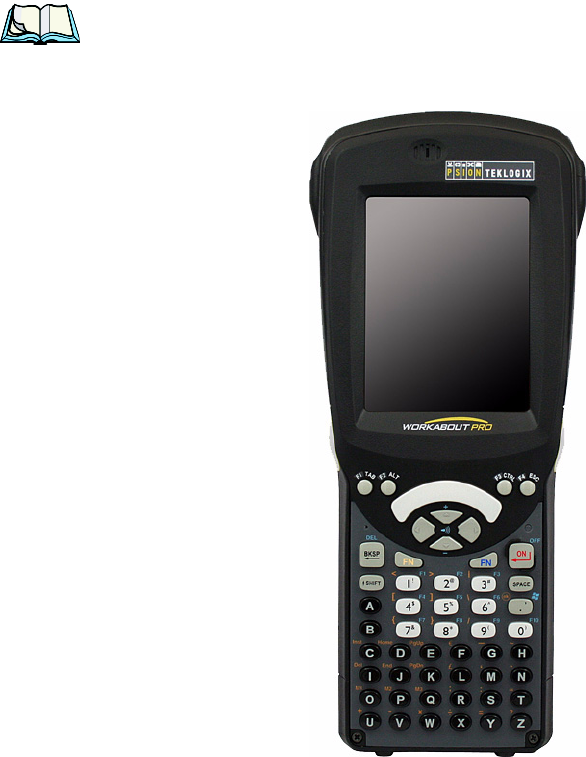
Chapter 1: Introduction
The WORKABOUT PRO C Hand-Held
6WORKABOUT PRO Hand-Held Computer With Windows CE 5.0 User Manual
Note: 802.11b/g, GSM, and Bluetooth are available simultaneously.
1.3.1 The WORKABOUT PRO C Hand-Held
Figure 1.1 WORKABOUT PRO C With 52-Key Keyboard
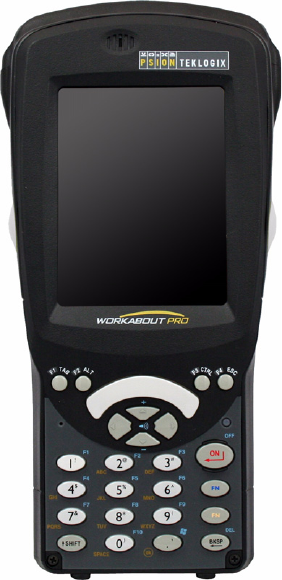
WORKABOUT PRO Hand-Held Computer With Windows CE 5.0 User Manual 7
Chapter 1: Introduction
The WORKABOUT PRO S Hand-Held
1.3.2 The WORKABOUT PRO S Hand-Held
Figure 1.2 WORKABOUT PRO S With 25-Key Keyboard

WORKABOUT PRO Hand-Held Computer With Windows CE 5.0 User Manual 9
BASIC CHECKOUT 2
2.1 Preparing The WORKABOUT PRO For Operation............11
2.1.1 The Main Battery...........................11
2.1.1.1 Charging The Main Battery.................11
2.1.2 The Backup Battery. . . . . . . . . . . . . . . . . . . . . . . . . . 12
2.2 Turning The WORKABOUT PRO On And Off . . . . . . . . . . . . . . 12
2.2.1 Installing The Battery And Switching The Unit On . . . . . . . . . 12
2.2.2 Switching The Unit Off (Suspend)..................13
2.3 Calibrating The Touchscreen........................13
2.4 Configuring The Summit RA2041 802.11b/g . . . . . . . . . . . . . . . 13
2.4.1 Summit Client Utility (SCU) For Model RA2041 . . . . . . . . . . 14
2.4.2 Assigning The IP Address......................14
2.4.3 Name Servers Tab ..........................16
2.4.4 Using The SCU To Connect To The WLAN.............17
2.4.4.1 SSID.............................18
2.4.4.2 EAP Type..........................18
2.4.4.3 Encryption..........................18
2.5 Checking The Scanner...........................19
2.6 Data Transfer Between The PC & The Hand-Held.............20
2.6.1 Using Microsoft® ActiveSync®...................20
2.6.2 Using Microsoft® Vista® ......................20
2.7 Voice – Using The Phone Dialer . . . . . . . . . . . . . . . . . . . . . . 20
2.7.1 Dialing A Number..........................21
2.7.2 Voice Menu..............................22
2.7.3 File Menu – Phonebook Management . . . . . . . . . . . . . . . . 25
2.8 Resetting The Hand-Held..........................26
2.8.1 Performing A Warm Reset......................26
2.8.2 Performing A Cold Reset.......................27
2.8.2.1 Cold Resetting To The BooSt Menu. . . . . . . . . . . . . 27
2.8.2.2 Cold Resetting To The Windows 5.0 OS . . . . . . . . . . 27
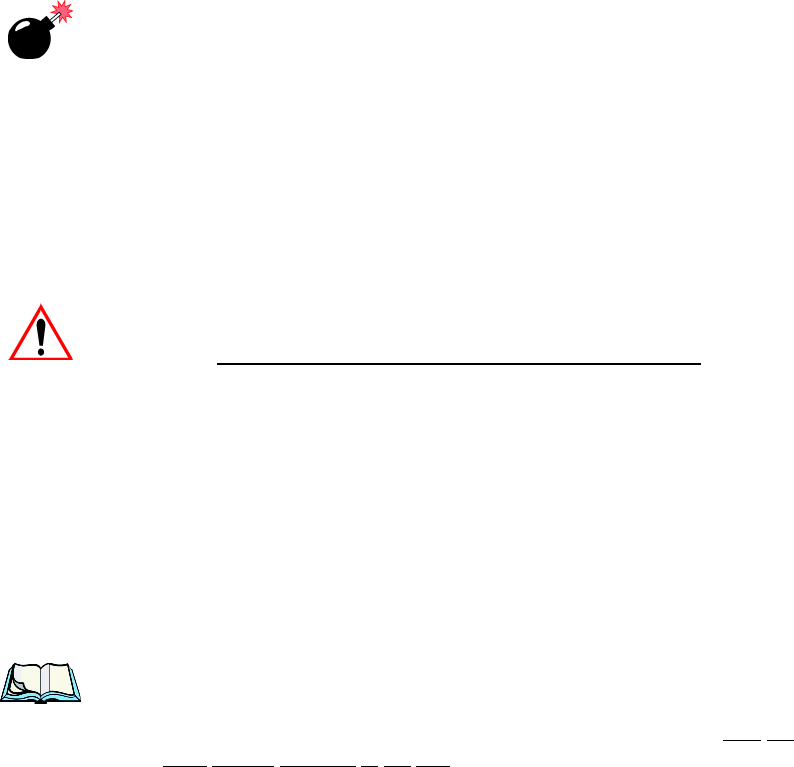
WORKABOUT PRO Hand-Held Computer With Windows CE 5.0 User Manual 11
Chapter 2: Basic Checkout
Preparing The WORKABOUT PRO For Operation
2.1 Preparing The WORKABOUT PRO For Operation
2.1.1 The Main Battery
Warning: Before charging the battery, it is critical that you review the battery
safety guidelines in the “WORKABOUT PRO Hand-Held Com-
puter Warranty & Regulatory Guide”, PN 8000126.
The WORKABOUT PRO C and WORKABOUT PRO S can be powered with one
of the following lithium-ion battery packs:
• High-Capacity – Model No. WA3006, and
• Super High-Capacity – Model No. WA3010
2.1.1.1 Charging The Main Battery
Important: Before opening the battery cover on your WORKABOUT PRO,
press [FN/BLUE] [ENTER] to turn off the hand-held. When the
battery cover is removed, a power-off switch is automatically acti-
vated and the unit power is switched off; if the battery cover is
opened while the hand-held is still powered on, the unit may
reboot.
Battery packs shipped from the factory are charged to approximately 40% and must
be fully charged prior to use. Batteries can be charged using a variety of chargers
and docking stations along with a WORKABOUT PRO internal charger. When
using the internal charger, a suitable power source is required. All chargers and
docking stations are described in Chapter 6: Peripheral Devices & Accessories
beginning on page 205.
Note: If you are powering up a new unit, a warning message may appear on the
screen indicating that the backup battery capacity is low. To recharge the
internal battery, you must fully charge the WORKABOUT PRO with the
main battery installed in the unit.

Chapter 2: Basic Checkout
The Backup Battery
12 WORKABOUT PRO Hand-Held Computer With Windows CE 5.0 User Manual
2.1.2 The Backup Battery
To preserve data stored in your WORKABOUT PRO while you swap the main
battery, the unit is equipped with a backup battery–a replaceable, rechargeable
Lithium-Ion backup battery that can be ordered through Psion Teklogix. The backup
battery will supply 5 minutes of continuous power while you install a charged,
main battery.
The backup battery is trickle charged from the main battery. Provided that the main
battery contains power, the backup battery will maintain a charge whether the
WORKABOUT PRO is switched on or off, in a docking station or in a cradle. Even
when the main battery reaches its Suspend Threshold (refer to “Suspend Threshold”
on page 100) and the hand-held shuts down, the backup battery will continue to
draw a trickle charge from the main battery to protect the data stored in the unit until
a charged main battery is installed.
Note: The backup battery takes approximately 3 to 4 hours to fully charge from
a fully discharged (flat) state, generally the same amount of time it takes
to fully charge the main battery. While you can continue to use the
WORKABOUT PRO, replacing the main battery while the backup battery
is not fully charged is not recommended because you risk losing the data
stored on the unit.
2.2 Turning The WORKABOUT PRO On And Off
2.2.1 Installing The Battery And Switching The Unit On
Important: Press [FN/BLUE] [ENTER] to turn off the hand-held before
opening the battery cover on your WORKABOUT PRO. When the
battery cover is removed, a power-off switch is automatically acti-
vated switching the unit off; if the battery cover is opened while
the hand-held is still powered on, the unit may reboot.
• To unlock the battery cover, turn the left-hand battery fastener to the left,
and turn the right-hand battery fastener to the right.
• Remove the battery cover.
• Ensure that the ON/OFF switch in the battery compartment is set to ON
before inserting the battery.

WORKABOUT PRO Hand-Held Computer With Windows CE 5.0 User Manual 13
Chapter 2: Basic Checkout
Switching The Unit Off (Suspend)
• Snap the charged battery into the unit. Replace the battery cover, and lock
the fasteners in place.
Note: If you are using a docking station or an external power supply, you can
insert an uncharged battery and switch it on.
To switch on the WORKABOUT PRO:
• Press and hold down the [ENTER] key for at least one second.
• When the LED flashes green, release the [ENTER] button.
The desktop screen is displayed.
Note: If the unit was already in use–the unit may be off (suspend state)–press-
ing [ENTER] ‘wakes’ the unit from this state. The screen in which you
were working prior to the suspend state is displayed. describes how you
can assign other ‘wakeup’ keys or enable a two-key ‘power on’ sequence.
2.2.2 Switching The Unit Off (Suspend)
• Press the [FN/BLUE] key, and then press [ENTER].
2.3 Calibrating The Touchscreen
Note: Keep in mind that the touchscreen function can be turned off (see
“Touch” on page 104).
The WORKABOUT PRO touchscreen is factory-calibrated and ready-to-go;
however, over time the touchscreen operating parameters may change, and it may
need to be recalibrated for correct operation. Refer to “Calibrating The
Touchscreen” on page 41 for details.
2.4 Configuring The Summit RA2041 802.11b/g
Psion Teklogix supports an 802.11b/g Compact Flash (CF) wireless LAN radio
card, model number RA2041. It is a Direct Sequence Spread Spectrum radio.
If you’re unit is equipped with an RA2041 CF radio, follow the steps under
“Summit Client Utility (SCU) For Model RA2041” to set up this type of radio for
communication with a wireless LAN.
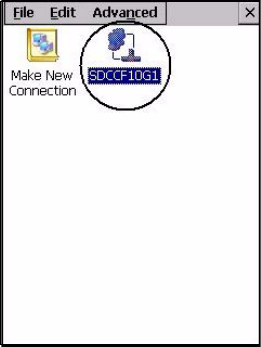
Chapter 2: Basic Checkout
Summit Client Utility (SCU) For Model RA2041
14 WORKABOUT PRO Hand-Held Computer With Windows CE 5.0 User Manual
2.4.1 Summit Client Utility (SCU) For Model RA2041
This section describes the Summit Client Utility (SCU). The SCU provides the
utilities you will need to configure the Summit 802.11b/g Compact Flash radio
module, model number RA2041 so that it can communicate through a wireless LAN
effectively and securely.
2.4.2 Assigning The IP Address
Before launching the SCU, you need to configure how the IP address will be
obtained. If your network is not using a DHCP server, you will need to assign an
IP address.
1. Tap on Start>Settings>Network and Dial-up Connections. (If the
Start Menu isn’t displayed in the taskbar, press [FN/BLUE] [0] to
display it.)
If you’re using the keyboard, press [FN/BLUE] [0] to display the Start
Menu. Use the [DOWN] arrow key to highlight Settings. Press the
[RIGHT] arrow key to display the sub-menu. Highlight Network, and press
[ENTER].
2. Choose the Summit WLAN Adapter icon to open the 802.11b/g Wire-
less LAN Settings window. In Figure 2.1, this icon is labelled
SDCCF10G1.
Figure 2.1 Summit WLAN Adapter Icon
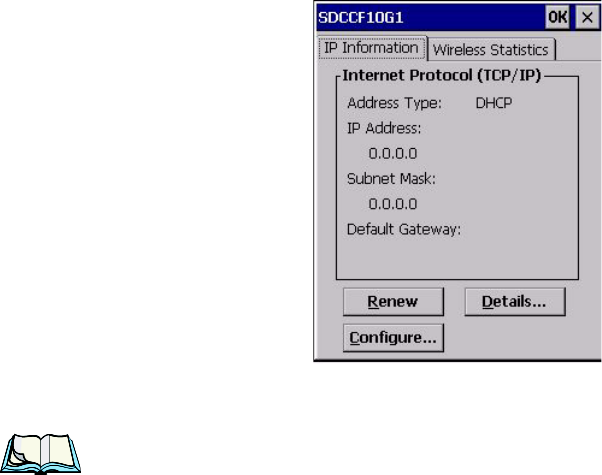
WORKABOUT PRO Hand-Held Computer With Windows CE 5.0 User Manual 15
Chapter 2: Basic Checkout
Assigning The IP Address
The Summit WLAN Adapter Settings menu is displayed (In this screen
shown as the SDCCF10G1 menu).
3. Tap on the IP Information tab.
Figure 2.2 IP Information Tab
Note: Choosing the Renew button forces the WORKABOUT PRO to renew or
find a new IP address. This is useful if, for example, you are out of com-
munication range for a longer period of time and your WORKABOUT
PRO is dropped from the network.
4. To define a static IP address, tap on the Configure button. The Summit
WLAN Adapter Settings menu provides two options:
• Tap on Obtain an IP address via DHCP to have an address assigned
automatically, or
• If you want to use a particular IP address, tap on Specify an IP address,
and type the preferred address as well as the IP, Subnet Mask and
Default Gateway addresses in the appropriate fields. Tap OK to save
your information.
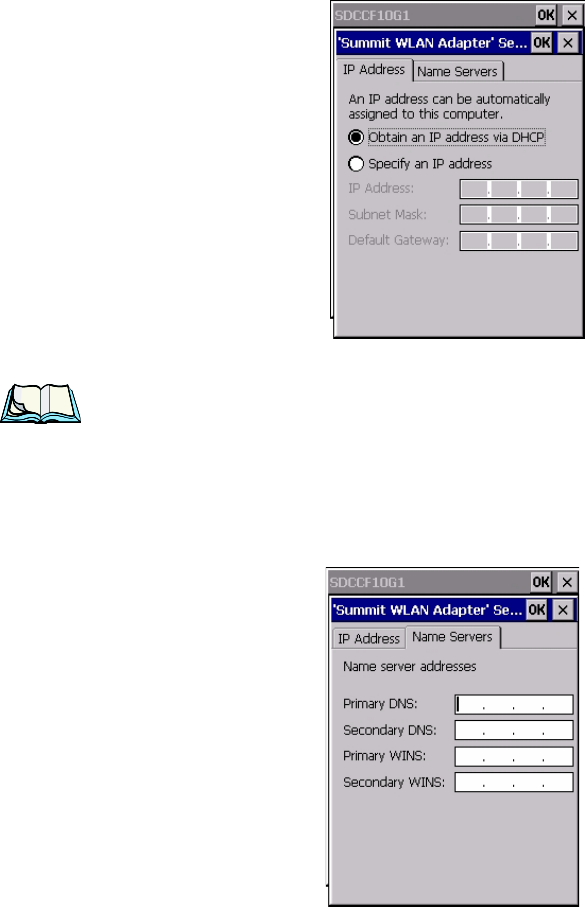
Chapter 2: Basic Checkout
Name Servers Tab
16 WORKABOUT PRO Hand-Held Computer With Windows CE 5.0 User Manual
2.4.3 Name Servers Tab
Note: If DHCP is enabled, name server addresses are assigned automatically.
•In the SDCCF10G1 window, display the IP Information tab.
•In the Summit WLAN Adapter Settings>IP Information tab, tap on the
Configure button.
• Display the Name Servers tab.
The DNS and WINS fields in the Name Servers tab allow you to specify additional
WINS and DNS resolvers. The format for these fields is ###.###.###.###.
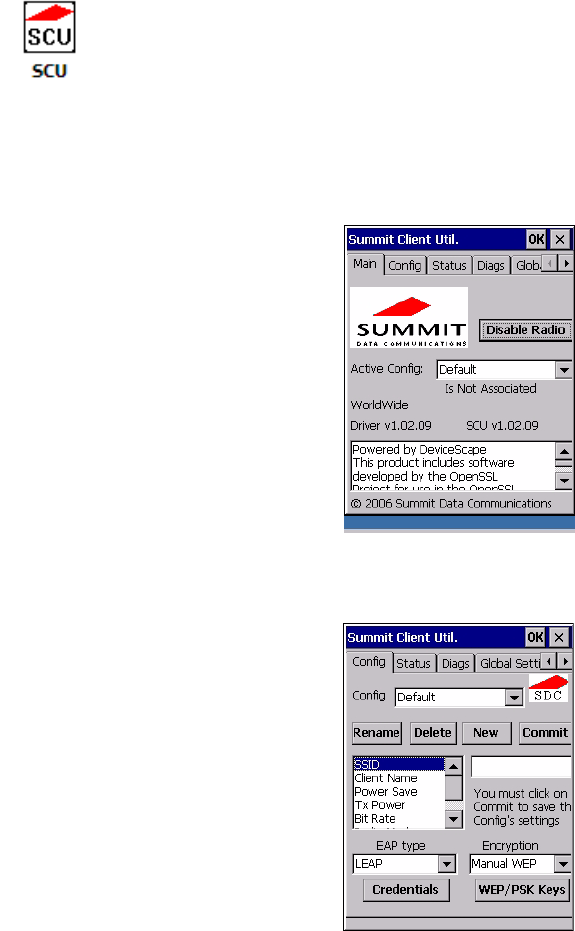
WORKABOUT PRO Hand-Held Computer With Windows CE 5.0 User Manual 17
Chapter 2: Basic Checkout
Using The SCU To Connect To The WLAN
2.4.4 Using The SCU To Connect To The WLAN
This section provides a quick set of steps to create a profile (referred to as a
“config”). Detailed information about each of the SCU tabs—Main, Config, Status,
Diags and Global Settings—is provided in Appendix C: Summit Client Utility
(SCU) For Model RA2041. To launch the SCU so that your WORKABOUT PRO
can connect to a wireless LAN:
• Tap on Start>Programs>Summit, and then tap on the SCU icon.
Figure 2.3 SCU Main Tab
• Tap on the Config tab.
Figure 2.4 SCU Config Tab

Chapter 2: Basic Checkout
SSID
18 WORKABOUT PRO Hand-Held Computer With Windows CE 5.0 User Manual
• Tap on the New button to define a new config.
• Type a name for your configuration using any alpha-numeric combination
to uniquely identify this config.
• Tap on OK to return to the Config tab.
• Tap on Commit to save the config name.
• When a pop-up message indicates that your configuration will be saved, tap
on OK.
2.4.4.1 SSID
To configure the SSID for the network to which you want to associate:
• Type an SSID in the text box to the right of SSID. This field is limited to 32
characters.
• Tap on Commit and then, in the pop-up message, tap on OK to save your
SSID setting.
Important: To learn more about the other options available in the radio
attributes list, refer to Appendix C, page C-2
2.4.4.2 EAP Type
• Tap on the EAP type drop-down menu, and choose the appropriate type of
authentication—LEAP, EAP-FAST, PEAP-MSCHAP, and PEAP-GTC.
• Next, tap on the Credentials button, and type credentials for IEEE 802.1X
EAP types.
Important: Refer to Appendix C: Summit Client Utility (SCU) For Model
RA2041, page C-4 for details about security settings. Additional
EAP details are described in “EAP Credentials” on page C-6.
2.4.4.3 Encryption
• Tap on the Encryption drop-down menu, and choose the appropriate type
of encryption—Manual WEP, Auto WEP, WPA PSK, WPA TKIP,
WAP2PSK, WAP2 AES, and CCKM TKIP.
If you choose Manual WEP, WPA PSK or WPA PSK:
• Tap on the WEP/PSK Keys button. For Manual WEP, choose up to four
static WEP keys. For PSK, type an ASCII passphrase or hex PSK.

WORKABOUT PRO Hand-Held Computer With Windows CE 5.0 User Manual 19
Chapter 2: Basic Checkout
Checking The Scanner
• Configure any other settings that are supplied by the network administrator
for the SSID to which you will associate.
• Make certain that you tap on Commit following each change.
Once you’ve completed the configuration:
• Tap the Main tab. Tap on the Active Config button – your new config will
be listed in the drop-down menu.
When you tap on the config you created, the RA2041 radio module attempts to
connect to the network using the following steps:
- Associate to the SSID.
- Authenticate to the network.
- If EAP authentication is being used, derive dynamic encryption keys.
- If DHCP is being used by the network, obtain an IP address.
If the RA2041 is not connecting properly:
• Tap on the Status tab.
The Status dialog box lists the IP and MAC addresses, and indicates the current state
of the radio, the signal strength, channel and so on.
You can also use the Status screen for DHCP renewal and ICMP Echo Requests
(Pings).
Important: For details about the Status dialog box, refer to Appendix C, page
C-9.
2.5 Checking The Scanner
If your WORKABOUT PRO is equipped with an internal scanner, you can test it to
ensure that it is operating properly. Point the scanner window at a bar code that your
scanner was designed to decode—for example, a 1D UPC bar code or 2D bar code.
Press the SCAN key or pistol trigger, and check for a valid decode on the hand-
held’s screen.
Performance is improved if you disable all unneeded bar codes in the Bar Codes
screen. Review “Scanner Settings” on page 134 for details about bar codes.

WORKABOUT PRO Hand-Held Computer With Windows CE 5.0 User Manual 27
Chapter 2: Basic Checkout
Performing A Cold Reset
A warm reset closes open applications; any unsaved data are lost. Installed
programs and saved data are preserved.
Note: You do not need to reset your WORKABOUT PRO after configuring the
radio.
2.8.2 Performing A Cold Reset
2.8.2.1 Cold Resetting To The BooSt Menu
• Press and hold down the centre [SCAN] bar and then press the [FN/BLUE]
and [ENTER] keys simultaneously for a minimum of six seconds.
After a cold reset, the BooSt menu appears, listing possible BooSt commands.
• To load the Windows CE 5.0 operating system, type 1.
2.8.2.2 Cold Resetting To The Windows 5.0 OS
To perform a cold reset and launch the Windows 5.0 operating system (bypassing
the BooSt menu):
• Press and hold down the [FN/BLUE] [FN/ORANGE] and [ENTER] keys
simultaneously for a minimum of six seconds.

WORKABOUT PRO Hand-Held Computer With Windows CE 5.0 User Manual 29
GETTING TO KNOW YOUR WORKABOUT PRO 3
3.1 Features Of The WORKABOUT PRO ....................31
3.2 The Battery...................................33
3.2.1 Battery Safety.............................33
3.2.2.1 Battery Swap Time .....................33
3.2.2 Removing The Battery Pack.....................33
3.2.3 Charging The Battery.........................34
3.2.3.1 Chargers And Docking Stations . . . . . . . . . . . . . . . 34
3.3 Switching The Hand-Held On And Off....................35
3.4 The Keyboard..................................36
3.4.1 Modifier Keys ............................36
3.4.1.1 Activating Modifier Keys . . . . . . . . . . . . . . . . . . 37
3.4.1.2 Locking Modifier Keys...................37
3.4.2 The Keys...............................37
3.4.3 Function Keys And Macro Keys . . . . . . . . . . . . . . . . . . . 38
3.4.3.1 Function Keys........................38
3.4.3.2 Macro Keys (WORKABOUT PRO C Only) . . . . . . . . 39
3.4.4 52-Key Keyboard – Accessing Alpha Keys . . . . . . . . . . . . . 39
3.4.5 25-Key Keyboard – Accessing Alphanumeric Keys . . . . . . . . . 39
3.4.6 The Keypad Backlight........................41
3.5 The Display...................................41
3.5.1 Adjusting The Display Backlight...................41
3.5.2 Calibrating The Touchscreen.....................41
3.6 WORKABOUT PRO Indicators........................43
3.6.1 LED..................................43
3.6.2 Audio Indicators...........................43
3.6.2.1 Adjusting WORKABOUT PRO Speaker Volume. . . . . . 44
3.6.3 Onscreen Indicators..........................44
3.7 Monitoring The Battery And Maximizing Run Time.............47
3.7.1 Storing Batteries ...........................47
3.8 Uploading Data In A Docking Station.....................48
3.9 Bluetooth Radio ................................48
3.9.1 Pairing A Bluetooth Headset Or Other Bluetooth Device . . . . . . 49
3.10 Inserting The SD/MMC Card And SIM Card ................49
30 WORKABOUT PRO Hand-Held Computer With Windows CE 5.0 User Manual
3.10.1 Inserting The Card..........................49
3.11 General Maintenance ............................ 50
3.11.1 Caring For The Touchscreen.....................50
3.11.2 Cleaning The WORKABOUT PRO.................50
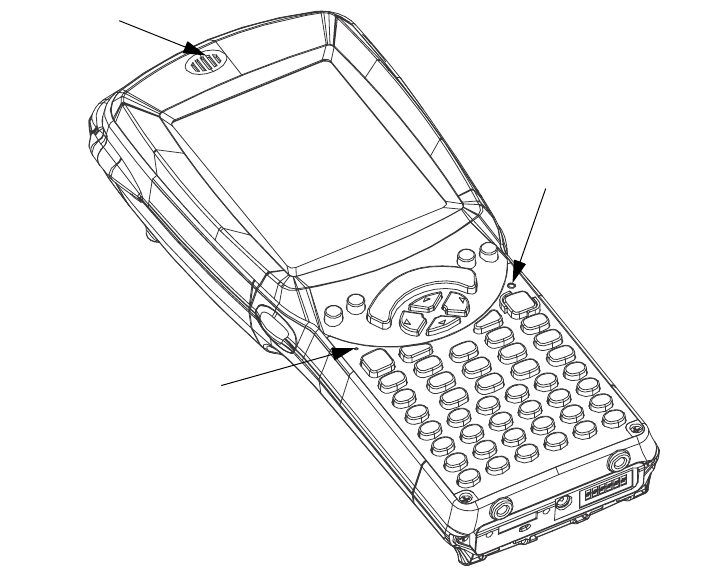
WORKABOUT PRO Hand-Held Computer With Windows CE 5.0 User Manual 31
Chapter 3: Getting To Know Your WORKABOUT PRO
Features Of The WORKABOUT PRO
3.1 Features Of The WORKABOUT PRO
Figure 3.1 Front Of WORKABOUT PRO
Speaker
Microphone Port
LED
(Light Emitting Diode)
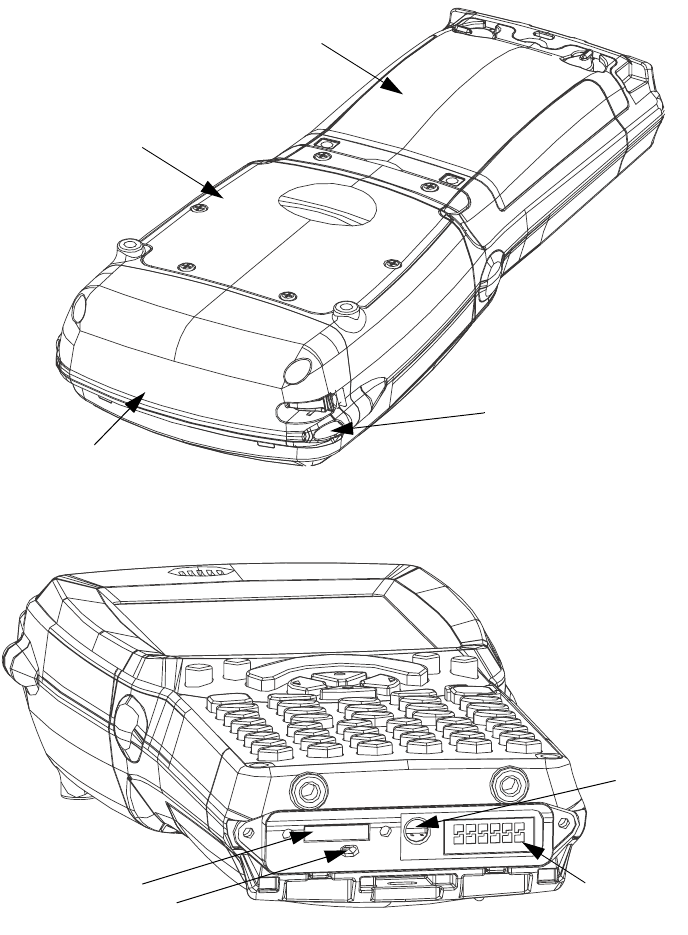
Chapter 3: Getting To Know Your WORKABOUT PRO
Features Of The WORKABOUT PRO
32 WORKABOUT PRO Hand-Held Computer With Windows CE 5.0 User Manual
Figure 3.2 Back Of WORKABOUT PRO
Figure 3.3 Ports
Stylus
(Pointing Tool)
Scanner Window
Battery Pack
Tether Port
Warning Label
Battery Cover
Back Cover
End-Cap
Stylus
(pointing tool)
Tether Port Low Insertion
Force Port (LIF)
DC IN Socket
Beeper Port
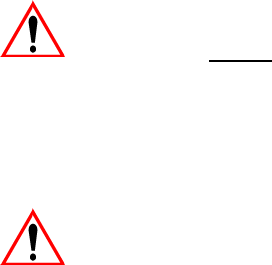
WORKABOUT PRO Hand-Held Computer With Windows CE 5.0 User Manual 33
Chapter 3: Getting To Know Your WORKABOUT PRO
The Battery
3.2 The Battery
The hand-held operates with a Lithium-Ion battery pack. Preparing the unit for
operation requires that a battery pack be charged and installed in the
WORKABOUT PRO.
Three levels of battery packs are available for the WORKABOUT PRO:
• High-Capacity – Model No. WA3006, and
• Super High-Capacity – Model No. WA3010
3.2.1 Battery Safety
Important: Before attempting to install, use or charge the battery pack, it is
critical that you review and follow the important safety guidelines
in the quick reference guide entitled ‘WORKABOUT PRO
Hand-Held Computer Regulatory & Warranty Guide’, PN
8000126.
3.2.2 Removing The Battery Pack
Important: Always switch the unit off before opening the battery cover to
remove the battery. When the cover is removed, a power-off switch
is automatically activated and the unit power is switched off; if the
battery cover is opened while the hand-held is still powered on,
the unit may reboot. Any active sessions may be lost.
Keep in mind also that while the battery is being replaced, the
WORKABOUT PRO backup battery will save the current data for
up to 5 minutes.
Refer to “Installing The Battery And Switching The Unit On” on page 12.
3.2.2.1 Battery Swap Time
Assuming the default power saving parameters and battery reserve level have not
been altered, battery swap time is approximately 5 minutes—you will not lose data
if the battery is replaced within this time frame.
To protect data, the safest place to store data is on a SD/MMC memory card or
externally to the device on a USB memory stick or on a PC. You can also
save data in the “Flash Disk” partition of the file system.

Chapter 3: Getting To Know Your WORKABOUT PRO
Charging The Battery
34 WORKABOUT PRO Hand-Held Computer With Windows CE 5.0 User Manual
The Suspend Threshold adjustment in the Power Properties tab allows you to
determine the battery capacity at which the hand-held will be shut down. If left at
the default value, Maximum Operating Time, the unit will run until the battery is
completely empty; the RAM is only backed up for a short period of time. If you
choose Maximum Backup Time, the hand-held shuts off with more energy left in the
battery so RAM can be backed up for a longer period of time.
Refer to “Suspend Threshold” on page 100 for details about reserving battery power
for data backup purposes.
3.2.3 Charging The Battery
Batteries shipped from the factory are charged to approximately 40% of capacity.
They must be fully charged prior to use.
Keep in mind also that, along with the main battery, the WORKABOUT PRO is
equipped with an internal, backup battery that preserves data stored on the unit
while the main battery is swapped.
Important: The backup battery is trickle charged from the main battery. To
maximize battery life, avoid excessive discharging and recharging
of the backup battery by keeping the main battery fully charged.
IF YOU ARE POWERING UP A NEW UNIT, a warning message
may appear on the screen indicating that the backup battery
capacity is low. To recharge the backup battery, you must fully
charge the WORKABOUT PRO with the main battery installed in
the unit.
3.2.3.1 Chargers And Docking Stations
Important: FOR DETAILED INFORMATION about chargers and docking
stations, refer to “Peripheral Devices & Accessories” on
page 205.
Lithium Ion battery packs must be charged before use. These batteries can be
charged with a variety of chargers and docking stations. These include:
• AC wall adaptor (Model # PS1050-G1) – operates as an AC power source
and when plugged in, also charges the battery installed in the unit.
• Desktop Docking Station (Model # WA4003-G2)—operates as both a
charger and a docking station. Operating as a charger, both the battery
installed in the hand-held and a spare battery can be charged simulta-
neously.

WORKABOUT PRO Hand-Held Computer With Windows CE 5.0 User Manual 35
Chapter 3: Getting To Know Your WORKABOUT PRO
Switching The Hand-Held On And Off
• Quad Docking Station — (Model # WA4204-G2 for WORKABOUT PRO
C & Model # WA4304-G2 for WORKABOUT PRO S) can charge the
battery of up to four WORKABOUT PROs inserted in the docking station.
• Single Battery Charger (Model # WA3001-G1)—charges a single battery.
• Quad Battery Charger (Model # WA3004-G1)—charges up to four spare
High or Super-High Capacity WORKABOUT PRO battery packs.
It can take up to 5 hours to charge a battery. The WORKABOUT PRO intelligent
charging system protects the battery from over-charging by terminating the charge
process when the battery is at maximum capacity.
Note: Refer to “Monitoring The Battery And Maximizing Run Time” on page 47
for additional information about the battery.
Important: To avoid damaging the battery, chargers will not begin the charge
process until the battery temperature is between 0° C to 45 °C
(32° F to 113° F).
3.3 Switching The Hand-Held On And Off
Switching On The WORKABOUT PRO
Note: Whenever the battery cover is removed, an auto-shutoff switch is acti-
vated. The battery cover must be installed before the unit can be switched
on.
• Press the [FN/BLUE] key and then, press and hold down the [ENTER] key
for at least one second.
• When the LED flashes green, release the [ENTER] button.
If the unit does not power up, the power ON/OFF switch located in the battery
compartment may be set to OFF. In this case, you’ll need to remove the battery
cover and battery and slide the ON/OFF switch to ON.
The startup screen is displayed.
Note: If the WORKABOUT PRO is in suspend state, pressing [ENTER] ‘wakes’
the unit from this state. The screen in which you were working before the
computer entered suspend state is displayed.“Wakeup” on page 102
describes how you can assign other ‘wakeup’ keys.

Chapter 3: Getting To Know Your WORKABOUT PRO
The Keyboard
36 WORKABOUT PRO Hand-Held Computer With Windows CE 5.0 User Manual
Switching Off The WORKABOUT PRO (Suspend)
Important: Keep in mind that turning off the WORKABOUT PRO does not
result in a complete reboot; rather, the unit enters a power-saving,
“suspend” state. When the unit is turned on from suspend state,
operation resumes within a few seconds.
To switch off the WORKABOUT PRO:
• Press the [FN/BLUE] key, and then press the [ENTER] key.
3.4 The Keyboard
The WORKABOUT PRO is available in two models, each with it’s own keyboard
layout. The WORKABOUT PRO C model is equipped with a 52-key, alphanumeric
keyboard; the WORKABOUT PRO S model is equipped with a 25-key numeric
keyboard.
Most of the keys on these keyboards operate much like a desktop computer. Where a
key or key function is not consistent with the PC keyboard, the differences are
noted.
The [FN/BLUE] and [FN/ORANGE] modifier keys provide access to additional
keys and system functions. These functions are colour coded in orange and blue
print above the keyboard keys.
3.4.1 Modifier Keys
The [SHIFT], [CTRL], [ALT], [FN/BLUE] and [FN/ORANGE] keys are modifier
keys. Pressing a modifier key changes the function of the next key pressed. For
example, on a WORKABOUT PRO C, 52-key keyboard, a square bracket is printed
in orange print above the [4] key. Pressing the [FN/ORANGE] key followed by the
[4] key displays a square bracket rather than the number 4.
The [SHIFT], [CTRL] and [ALT] keys operate much like a desktop keyboard except
that they are not chorded (two keys held down simultaneously). The modifier key
must be pressed first followed by the key whose function you want modified.
WORKABOUT PRO Hand-Held Computer With Windows CE 5.0 User Manual 37
Chapter 3: Getting To Know Your WORKABOUT PRO
Activating Modifier Keys
3.4.1.1 Activating Modifier Keys
When a modifier key is pressed once, it is displayed in lowercase letters in the
taskbar at the bottom of the hand-held screen. For example, if the [CTRL] key is
pressed, ctrl key is displayed at the bottom of the unit screen. Once the next key is
pressed, the modifier key becomes inactive and disappears from the taskbar.
Keep in mind, however, that the ‘One Shot’ function allows you to determine how
many key presses will lock a modifier key ‘on’ – one press or two. Refer to
“Keyboard One Shot Modes” on page 89 for details.
3.4.1.2 Locking Modifier Keys
When a modifier key is pressed twice, it is ‘locked’ on. A ‘locked’ modifier key is
displayed in uppercase letters in the taskbar. For example, pressing the [CTRL] key
twice locks it on—it is displayed as CTRL KEY in the taskbar at the bottom of the
computer screen.
The locked modifier key will remain active until it is pressed a third time to unlock
or turn it off. Once a modifier key is unlocked, the uppercase representation at the
bottom of the screen is no longer displayed.
3.4.2 The Keys
The [SHIFT] Key
The [SHIFT] key is used to display uppercase alpha characters and provide access to
the symbols above the numeric keys.
The Arrow Keys
The Arrow keys move the cursor around the screen in the direction of the arrow: up,
down, left and right. The cursor is the flashing box or underline character that
indicates where the next character you type will appear.
The [SPACE] Key
Pressing this key inserts a blank space between characters. In a Windows dialog
box, pressing the [SPACE] key enables or disables a checkbox. On WORKABOUT
PRO S models, this key is accessed by key combination – [FN/ORANGE] [0]
(zero).
Chapter 3: Getting To Know Your WORKABOUT PRO
Function Keys And Macro Keys
38 WORKABOUT PRO Hand-Held Computer With Windows CE 5.0 User Manual
The [BKSP/DEL] Key
The [BKSP] key (sometimes referred to as destructive backspace) moves the cursor
one character to the left, erasing the incorrectly entered key stroke.
The [DEL] key ([FN/BLUE] [BKSP]) erases the character at the cursor position.
The [CTRL] And [ALT] Key
The [CTRL] and [ALT] keys modify the function of the next key pressed and are
application dependent.
The [TAB] Key
Typically, the [TAB] key moves the cursor to the next field to the right or
downward.
The [ESC] Key
Generally, this key is used as a keyboard shortcut to close the current menu, dialog
box or activity and return to the previous one.
The [SCAN] Keys
All units are equipped with three yellow [SCAN] keys – one on the left side and one
on the right side of the unit along with a curved, yellow scan bar just below the
WORKABOUT PRO display. For units that do not have internal scanners, this key
can be re-mapped to another function.
3.4.3 Function Keys And Macro Keys
In addition to the standard keyboard functions, the WORKABOUT PRO supports
Function keys and Macro keys. All Function and Macro keys can be custom defined
for each application.
3.4.3.1 Function Keys
The WORKABOUT PRO keyboard is equipped with a total of 14 function keys.
Function keys [F1] to [F4] are located across the top of the keyboard next to the
[TAB], [ALT], [CTRL] and [ESC] keys and are directly accessible – a key
combination is not required. Ten additional function keys are colour coded in blue
print on the unit body; these keys are accessed by executing a key combination,
[FN/BLUE] followed by the appropriate numeric key.
For example, to access function key [F7]:

WORKABOUT PRO Hand-Held Computer With Windows CE 5.0 User Manual 39
Chapter 3: Getting To Know Your WORKABOUT PRO
Macro Keys (WORKABOUT PRO C Only)
• Press the [FN/BLUE] key followed by the [7] key – the numeric key to
which function key [F7] is mapped.
• To access function key [F8], press [FN/BLUE] [8], and so on.
3.4.3.2 Macro Keys (WORKABOUT PRO C Only)
Important: Refer to “Keyboard Macro Keys” on page 90 for details about
creating macros.
WORKABOUT PRO hand-helds are equipped with a series of macro keys that can
be programmed to replace frequently used keystrokes, along with the function of
executable keys like the [ENTER] key, the [BKSP] key, any function key and arrow
key, and so on.
Alphanumeric (52-keys) keyboards have three macro keys: [M1] to [M3]. These
keys are colour coded in orange print above alpha keys [O], [P] and [Q].
To access a macro key:
• Press the [FN/ORANGE] key followed by the appropriate alpha key from
[O] to [Q].
To access macro key [M1], press [FN/ORANGE] [O].
To access macro key [M2], press [FN/ORANGE] [P], and so on.
3.4.4 52-Key Keyboard – Accessing Alpha Keys
The alpha and numeric keys on WORKABOUT PRO C units are directly accessible
from the keyboard – no key combination is required.
3.4.5 25-Key Keyboard – Accessing Alphanumeric Keys
On 25-key WORKABOUT PROs, while numeric keys are directly accessible, all
alpha characters are printed on the unit plastic in orange typeface above the numeric
keys. An indicator in the left corner of the taskbar displays the currently selected
character. To access an alpha character, first press the [ORANGE] key and then
press the numeric key above which the alpha character you want to type is printed.
Choosing A Single Alpha Character
The examples below illustrate how to access, A, B and C, all of which are printed in
orange characters above the numeric key [2].
Important: The letters you choose appear in the taskbar, providing a visual
indicator of which letter will be displayed on the screen.

Chapter 3: Getting To Know Your WORKABOUT PRO
25-Key Keyboard – Accessing Alphanumeric Keys
40 WORKABOUT PRO Hand-Held Computer With Windows CE 5.0 User Manual
To choose the letter a:
• Press the [FN/ORANGE] key, and press the numeric key [2].
Note: To choose the second, third or fourth alpha character assigned to a
numeric key, you may want to lock the [FN/ORANGE] key ‘on’. By
default, the [FN/ORANGE] key is locked ‘on’ when pressed once. How-
ever, depending on how your unit is set up in the ‘One Shots’ tab, you may
find that you need to press the [FN/ORANGE] key twice to lock it ‘on’.
Refer to “Keyboard One Shot Modes” on page 89for details.
To choose the second letter in the sequence—in this example, the letter b:
• Lock the [FN/ORANGE] key ‘on’. ‘ORG KEY is displayed in upper-case
characters in the taskbar to indicate that this key is locked ‘on’.
• Press numeric key [2] twice to display the letter b.
To choose the third letter in the sequence—in this example, the letter c:
• Lock the [FN/ORANGE] key ‘on’.
• Press numeric key [2] three times to display the letter c.
Note: Keep in mind that there is a timeout if you pause for one second between
key presses when selecting the second, third or fourth letters on a key. For
example, suppose you want to type the letter ‘c’–you’d need to press the
[2] key three times. With the [FN/ORANGE] key locked ‘on’, if you press
[2] twice and then pause between key presses for 1 second, the letter ‘b’
will be selected automatically.
Creating Uppercase Letters
To display a capital letter:
• Press the [FN/ORANGE] key and then the [SHIFT] key before typing the
alpha character.
Note: If you want to use uppercase characters at all times, press [FN/BLUE]
[SHIFT]. An icon of an uppercase ‘A’ is displayed in the taskbar indicating
that all letters will be displayed as uppercase characters.
Choosing Multiple Alpha Characters
• Lock the [FN/ORANGE] key ‘on’.

WORKABOUT PRO Hand-Held Computer With Windows CE 5.0 User Manual 41
Chapter 3: Getting To Know Your WORKABOUT PRO
The Keypad Backlight
Each time you press a numeric key from [2] through [9], an alpha character will be
displayed on the screen. Remember that you can refer to the softkey bar for a visual
indication of which alpha key will be displayed on the screen.
Important: Once you have finished typing alpha characters, remember to
turn off or unlock the [FN/ORANGE] key.
3.4.6 The Keypad Backlight
The intensity of the keypad backlight and the conditions under which this backlight
is activated can be configured using the Keyboard icon in the Windows CE 5.0
Control Panel. The behaviour of the keypad backlight is tailored in the Keyboard
Properties dialog box. Refer to “Keyboard Backlight” on page 88 for details about
this option.
Note: Keep in mind that this option may be restricted to supervisory use only.
3.5 The Display
WORKABOUT PROs are equipped with display backlighting to improve character
visibility in low light conditions. The backlight switches on when a key is pressed or
the screen is tapped.
3.5.1 Adjusting The Display Backlight
The Display Properties dialog box in the Control Panel allows you to determine
the behaviour of the display backlight and its intensity. Refer to “Display
Backlight” on page 85 for details about the Display Properties dialog box.
3.5.2 Calibrating The Touchscreen
If your WORKABOUT PRO touchscreen has never been calibrated, or if you find
that the stylus pointer is not accurate when you tap on an item, use the Stylus
Properties dialog box in the Control Panel to recalibrate the screen.
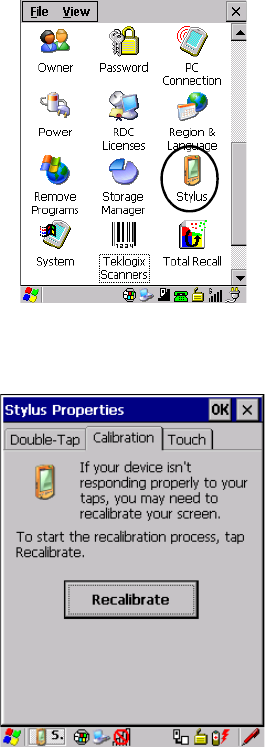
Chapter 3: Getting To Know Your WORKABOUT PRO
Calibrating The Touchscreen
42 WORKABOUT PRO Hand-Held Computer With Windows CE 5.0 User Manual
•In the Control Panel, choose the Stylus icon to display the Stylus Proper-
ties window.
Figure 3.4 Stylus Icon
• Select the Calibration tab, and then choose the Recalibrate button.
Figure 3.5 Calibration Screen
• Follow the directions on the calibration screen to calibrate the screen.
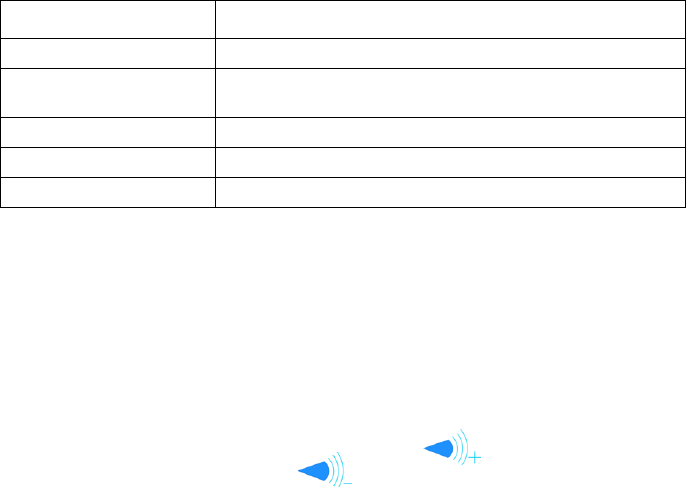
WORKABOUT PRO Hand-Held Computer With Windows CE 5.0 User Manual 43
Chapter 3: Getting To Know Your WORKABOUT PRO
WORKABOUT PRO Indicators
3.6 WORKABOUT PRO Indicators
The WORKABOUT PRO uses an LED (Light Emitting Diode), onscreen messages
and audio tones to indicate the various conditions of the hand-held, the batteries, the
scans and so on.
3.6.1 LED
A single, two-coloured LED is located on the upper-right side of the keyboard, just
above the [ENTER] key. When you press [ENTER], the LED flashes green to
indicate that the unit has been powered up. The LED table following outlines the
behaviour of the LED while the unit is docked in a charger.
Keep in mind that the application running on the WORKABOUT PRO can dictate
how the LED operates. Review the documentation provided with your application to
determine LED behaviour.
If the unit is attached to an external power supply, the hand-held LED reflects the
battery charge status.
3.6.2 Audio Indicators
The audio speaker provides a variety of sounds when a key is pressed, a keyboard
character is rejected, scan input is accepted or rejected, an operator’s entry does not
match in a match field or the battery is low. To specify how you want your
WORKABOUT PRO to respond under various conditions, refer to “Volume And
Sound Properties” on page 96.
The volume keys are located above [UP ARROW] and [DOWN ARROW]. The
increase volume key is labelled with a plus symbol and the decrease volume
key is labelled with a minus symbol .
LED Behaviour Charge Status
Solid Green Charge complete.
Fast Blinking Green Charge in progress. Battery charged to less than 80%
capacity.
Slow Blinking Green Battery charged to greater than 80% of capacity.
Solid Red Temperature outside charge range (0° C to 50° C).
Blinking Red Battery is not charging. Battery fault.
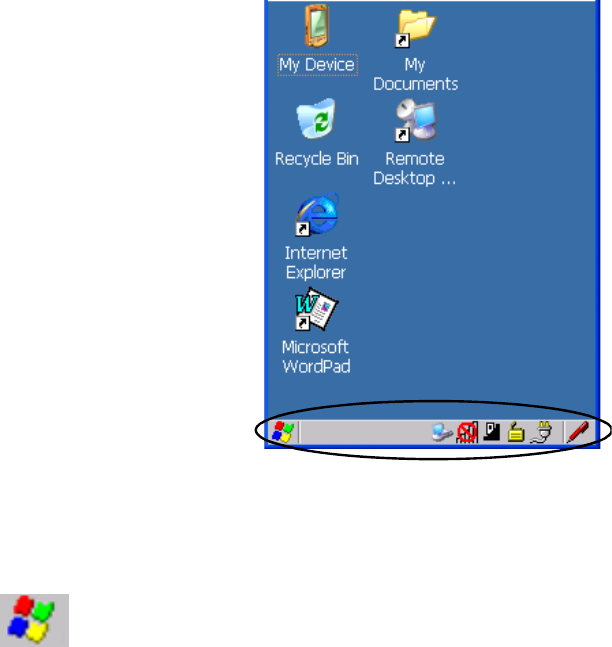
Chapter 3: Getting To Know Your WORKABOUT PRO
Adjusting WORKABOUT PRO Speaker Volume
44 WORKABOUT PRO Hand-Held Computer With Windows CE 5.0 User Manual
3.6.2.1 Adjusting WORKABOUT PRO Speaker Volume
• Lock the [FN/BLUE] key ‘on’ and then, press [UP ARROW]—the
increase volume key or [DOWN ARROW]—the decrease volume key until
the volume meets your requirements.
• Remember to press the [FN/BLUE] key again to turn it ‘off’.
3.6.3 Onscreen Indicators
The taskbar at the bottom of the screen displays a variety of system status indicators.
Figure 3.6 Taskbar
The taskbar changes dynamically, and only those icons that are applicable are
displayed. For example, if a radio is not installed in your WORKABOUT PRO, the
radio signal icon is not displayed in the taskbar.
Windows® Start Button
If you are using the touchscreen, you can either tap the Windows icon at the bottom
left of the screen, or press [FN/BLUE] [.] (period) to display the Start Menu, and
then tap on the desired application.
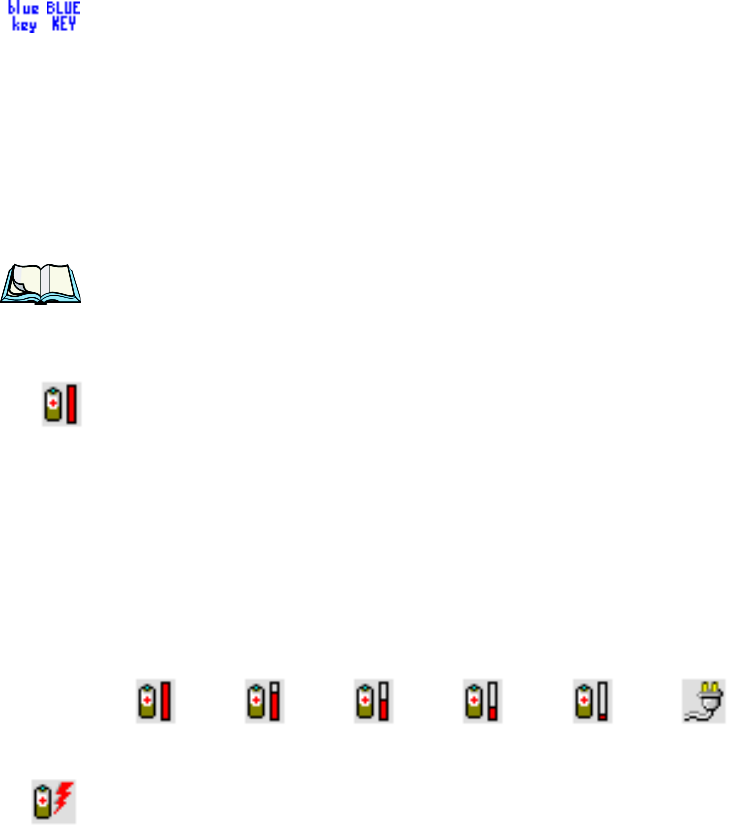
WORKABOUT PRO Hand-Held Computer With Windows CE 5.0 User Manual 45
Chapter 3: Getting To Know Your WORKABOUT PRO
Onscreen Indicators
Modifier Key Indicators
[SHIFT], [CTRL], [ALT], [FN/BLUE] and [FN/ORANGE] are modifier keys that
when pressed, are displayed in the taskbar to indicate that they are active. If a
modifier key is locked ‘on’, it is displayed in uppercase characters. For example, if
the [FN/BLUE] key is locked on, it is displayed as BLUE KEY in the taskbar. A locked
modifier key remains active until it is pressed again to unlock or turn it off.
If a modifier key has been pressed but is not locked on, it is displayed in the taskbar
in lowercase characters – for example, blue key. It will remain active only until the next
key is pressed at which point, the modifier key is turned off.
Note: The locking function of the modifier keys can be set up so that pressing
one of these keys once will lock the key ‘on’. They can also be set up so
that they must be pressed twice to be locked ‘on’. Refer to “Keyboard One
Shot Modes” on page 89for details.
Battery Gauge
The battery shaped icon displayed in the taskbar provides a visual indication of the
remaining battery power. The icon acts as a meter that is either full, at three-quarter
level, half, quarter level or empty.
When the battery level is low—approximately 15 minutes from empty—a warning
window pops up. When the battery power is completely depleted, a final warning
window indicates that the WORKABOUT PRO will be powered down.
If the WORKABOUT PRO is using external AC power, an AC icon is displayed in
the taskbar.
Battery Charge
The battery charge icon is displayed in the taskbar when the hand-held battery is
being charged.
AC ConnectionFull
75%
50% 25% Empty

WORKABOUT PRO Hand-Held Computer With Windows CE 5.0 User Manual 47
Chapter 3: Getting To Know Your WORKABOUT PRO
Monitoring The Battery And Maximizing Run Time
3.7 Monitoring The Battery And Maximizing Run Time
Note: When the main battery is at 50% capacity, a ‘low battery’ warning is dis-
played. When the battery is at approximately 10% capacity, a ‘very low
main battery’ notification appears.
As Lithium Ion batteries age, their capacity decreases gradually, and they are
generally considered depleted after approximately 2 years of use (less than 60% of
original capacity remaining). Keep in mind however that heavy usage or operating
the unit at temperature extremes will shorten the battery life.
Lithium Ion batteries do not require conditioning cycles and the WORKABOUT
PRO battery system (including chargers) requires no user interaction to maintain
peak performance.
To maximize the run time of your batteries, consider the following:
• The display backlight is the largest drain on the battery. Try to keep its
brightness as low as possible.
• The hand-held is ‘event’ driven—that is, when the unit is not in use, it
reverts to sleep mode (even when it appears to be running), saving battery
power. Events include a key press, touchscreen taps and scan triggers.
Power consumption is reduced if you avoid unnecessary events, and allow
the unit to sleep as much as possible.
• The battery is a ‘smart battery’ with built-in intelligence.
Tapping on the Power icon in the Control Panel displays a dialog box that
provides detailed information about the battery status of the main and
backup batteries installed in your unit.
• When the hand-held is switched off, it goes into a low-power, suspend state
but continues to draw a small amount of power from the battery. This
should not be an issue unless the unit is left in suspend state for more than a
week—for long-term storage, the battery should be removed from the unit.
3.7.1 Storing Batteries
Long term battery storage is not recommended. If storage is necessary:
• Always try to use a ‘first-in first-out’ approach to minimize storage time.
• Lithium Ion batteries age much faster at elevated temperatures. Store batter-
ies at temperatures between 0° C and 20° C.
• Always charge batteries to at least 40 to 60% before storing them. Batteries
can be damaged by an over-discharge phenomenon that occurs when an

Chapter 3: Getting To Know Your WORKABOUT PRO
Uploading Data In A Docking Station
48 WORKABOUT PRO Hand-Held Computer With Windows CE 5.0 User Manual
empty battery is stored for a long period of time such that the cell voltage
drops below a lower limit.
• To minimize storage degradation, recharge stored batteries to 40 to 60%
every 4 or 6 months to prevent over-discharge damage.
• A ‘never used’ Li-Ion battery that has been stored for 3 years may have
limited or no useful life remaining once put into service. Think of batteries
as perishable goods.
3.8 Uploading Data In A Docking Station
Important: Review the documentation provided with the user application installed
in your WORKABOUT PRO before performing data uploads.
The desktop docking station and quad docking station are typically used to upload
transaction data to a server computer when a radio link is not available.
Note: Refer to “Desktop Docking Station” on page 216 for more details.
The desktop docking station can complete batch uploads to a Client USB connected
PC or server. An optional 10/100baseT Ethernet module is also available.
Unlike the desktop docking station, the quad docking station supports only TCP/IP
connections to a PC or server through a 10/100baseT Ethernet connection.
When a WORKABOUT PRO is properly inserted in a docking station, a dock icon
is displayed in the navigation bar at the top of the screen. The unit also detects the
presence of the Ethernet network.
3.9 Bluetooth Radio
Note: Integrated Bluetooth class II radios are standard on WORKABOUT
PRO C and S units. Keep in mind also that Bluetooth is available simulta-
neously with WAN and 802.11g on a single unit.
The WORKABOUT PRO is equipped with an on-board Bluetooth radio. This type of
radio enables short range data communication between devices. The Bluetooth also
provides the capability to use a Bluetooth-enabled cellular phone as a data modem,
exchanging information with other Bluetooth devices and providing network access.
Refer to “Bluetooth Setup” on page 109 for setup details.
You can also pair your hand-set with a Bluetooth headset.

WORKABOUT PRO Hand-Held Computer With Windows CE 5.0 User Manual 49
Chapter 3: Getting To Know Your WORKABOUT PRO
Pairing A Bluetooth Headset Or Other Bluetooth Device
3.9.1 Pairing A Bluetooth Headset Or Other Bluetooth Device
Note: If the Bluetooth radio is not already enabled, tap on the Power icon in the
Control Panel, tap on the Devices tab and enable the Bluetooth radio.
To pair a headset:
• Follow the headset manufacturer’s instructions to place the headset you
want to place in pairing mode.
•In the Control Panel, tap on the Bluetooth icon choose the Devices tab and
Scan for devices in your area. (Note that if you’re pairing the device for the
first time, the device scan occurs automatically; you do not need to tap on
the Scan button to perform a scan.)
When the scan is complete, a list of devices is listed.
• Double-click on headset you want to pair with. If you prefer, you can high-
light headset and tap on the Services button.
A dialog box appears requesting that you enter a PIN number.
• Type your pin number and tap on OK.
A Services dialog box appears listing headset.
• Press and hold the stylus on headset. In the pop-up menu, choose Active.
Your headset is now paired. A COM/BSP port name will now appear beside the
service for this device. An asterisk will appear under the Active list in the Service
screen.
3.10 Inserting The SD/MMC Card And SIM Card
There are two slots available in the battery compartment – the lower slot is provided
for a SD/MMC (Secure Digital/Multi-Media Card) and the upper slot is for a SIM
(Subscriber Identity Module) card.
SD/MMC cards provide additional non-volatile memory to your hand-held. SIM
cards allow access to the hand-held Vo ic e option, access the Internet, and so on.
3.10.1 Inserting The Card
• Switch off the WORKABOUT PRO.
• Remove the battery cover and the battery.
A hinged door at the top of the battery compartment protects the connectors. It is
hinged on the left side.
• Pull the hinged SD door down as the arrow icon on the door indicates.

Chapter 3: Getting To Know Your WORKABOUT PRO
General Maintenance
50 WORKABOUT PRO Hand-Held Computer With Windows CE 5.0 User Manual
• Orient the SD/MMC or SIM card according to the legend stamped into the
battery well plastic.
• For SD/MMC cards, slide the card into the lower slot, pushing it inward
until it latches into place.
• For a SIM card, slide the card into the upper slot, pushing it inward until it
latches into place.
• Swing the hinged door back into place, and snap it shut.
To remove the card:
• Gently press it inward slightly until the detent unlatches, and the card is
expelled from the slot.
3.11 General Maintenance
3.11.1 Caring For The Touchscreen
The top of the touchscreen is a thin, flexible polyester plastic sheet with a
conductive coating on the inside. The polyester can be permanently damaged by
harsh chemicals and is susceptible to abrasions and scratches. Using sharp objects
on the touchscreen can scratch or cut the plastic, or crack the internal conductive
coating.
The chemicals listed below must not come into contact with the touchscreen:
• sodium hydroxide,
• concentrated caustic solutions,
• benzyl alcohol, and
• concentrated acids.
If the touchscreen is used in harsh environments, consider applying a disposable
screen protector (WA6110). These covers reduce the clarity of the display slightly
but will dramatically extend the useful life of the touchscreen. When they become
scratched and abraded, they are easily removed and replaced.
3.11.2 Cleaning The WORKABOUT PRO
Important: Do not immerse the unit in water. Dampen a soft cloth with mild
detergent to wipe the unit clean.
•Use only mild detergent or soapy water to clean the hand-held unit.
WORKABOUT PRO Hand-Held Computer With Windows CE 5.0 User Manual 51
Chapter 3: Getting To Know Your WORKABOUT PRO
Cleaning The WORKABOUT PRO
• Avoid abrasive cleaners, solvents or strong chemicals for cleaning. The
plastic case is susceptible to harsh chemicals. The plastic is partially soluble
in oils, mineral spirits and gasoline. The plastic slowly decomposes in
strong alkaline solutions.
• To clean ink marks from the keypad and touchscreen, use isopropyl
alcohol.

WORKABOUT PRO Hand-Held Computer With Windows CE 5.0 User Manual 53
WORKING WITH WINDOWS CE 5.0 4
4.1 Navigating In Windows CE 5.0........................55
4.1.1 Navigating Using A Touchscreen And Stylus . . . . . . . . . . . . 55
4.1.2 Navigating Using The Keyboard...................55
4.2 Working With Files, Folders And Programs..................56
4.3 The Startup Desktop..............................57
4.3.1 The Desktop Icons..........................58
4.3.2 The Taskbar..............................59
4.3.2.1 Using The Taskbar......................59
4.3.2.2 Customizing The Taskbar..................60
4.4 The Start Menu.................................62
4.4.1 The Desktop .............................63
4.4.2 Security Settings...........................63
4.4.3 Programs...............................65
4.4.4 Shortcuts...............................67
4.4.5 Settings................................69
4.4.6 Run..................................70
4.4.7 Shutdown...............................70
4.5 Using A Dialog Box..............................71

WORKABOUT PRO Hand-Held Computer With Windows CE 5.0 User Manual 55
Chapter 4: Working With Windows CE 5.0
Navigating In Windows CE 5.0
4.1 Navigating In Windows CE 5.0
Note: In order to access many of the menus discussed in this chapter, the secu-
rity level must be set to ‘Supervisor’ (see “Security Settings” on page 63).
Graphic user interfaces like Windows CE 5.0 for portable devices and desktop
Windows (2000, XP, etc.) utilize ‘point and click’ navigation. An equivalent
keyboard shortcut is also available for every ‘point and click’ action.
Windows CE 5.0 supports the same ‘point and click’ user interface and keyboard
shortcuts as desktop Windows with one difference—the ‘point and click’ action is
accomplished using a touchscreen rather than a mouse. Actions can be performed
using any combination of keyboard shortcuts or touchscreen tapping.
4.1.1 Navigating Using A Touchscreen And Stylus
Note: If the touchscreen is not registering your screen taps accurately, the
touchscreen may need recalibration. Refer to “Calibrating The Touch-
screen” on page 41.
Each WORKABOUT PRO is equipped with a stylus—a pointing tool that looks like
a pen—stored in a slot at the top of the unit. The stylus is used to select objects on
the touchscreen.
Note: To prevent damage to the touchscreen, use only the stylus (pen) supplied
with your WORKABOUT PRO.
To choose an icon, open a file, launch an applet or open a folder:
• Double-tap the stylus on the appropriate icon.
4.1.2 Navigating Using The Keyboard
If your WORKABOUT PRO touchscreen has been disabled, you can use the
keyboard to choose icons, navigate dialog boxes, display the desktop, and so on. If
your unit has already been fully configured and your application is launched at
startup, you’ll have little need for keyboard navigation, but you can refer to
Table 4.1 on page 56 for a description of the navigation keys.
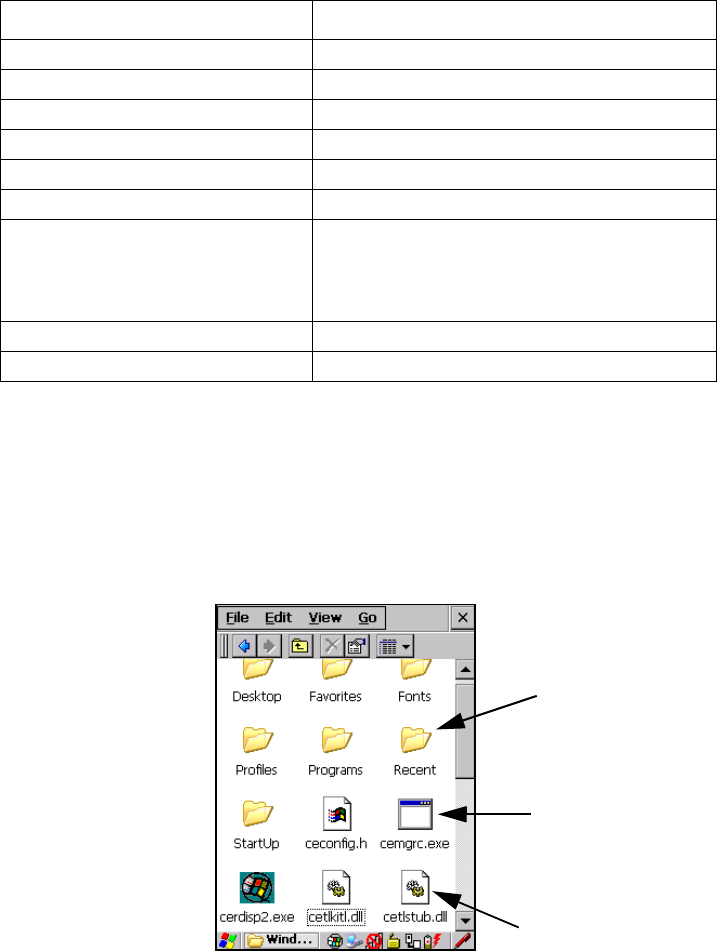
Chapter 4: Working With Windows CE 5.0
Working With Files, Folders And Programs
56 WORKABOUT PRO Hand-Held Computer With Windows CE 5.0 User Manual
Table 4.1 Keyboard Navigation
Keep in mind that unlike a desktop computer, the WORKABOUT PRO does not
support key chording (pressing two keys at the same time). You must press one key
followed by the next in sequence. Refer to “Working With Files, Folders And
Programs” for additional details about keyboard navigation.
4.2 Working With Files, Folders And Programs
Figure 4.1 Working With Windows Icons
Operation Key or Key Combination
Switch between active applications [ALT] [TAB]
Open task manager [ALT] [ESC]
Move the cursor Arrow keys
Open file, folder or icon [ENTER]
Exit & Save [ENTER]
Close/Exit & Do Not Save [ESC]
Navigate Dialog Boxes
[TAB]
To move cursor up [SHIFT] [TAB]
To display the contents of the next ‘tab’ in
a dialog box [CTRL] [TAB]
Select Radio Button/Press Button [SPACE]
Go to Start Menu [FN/BLUE][0]
Folder
File
Program Icon
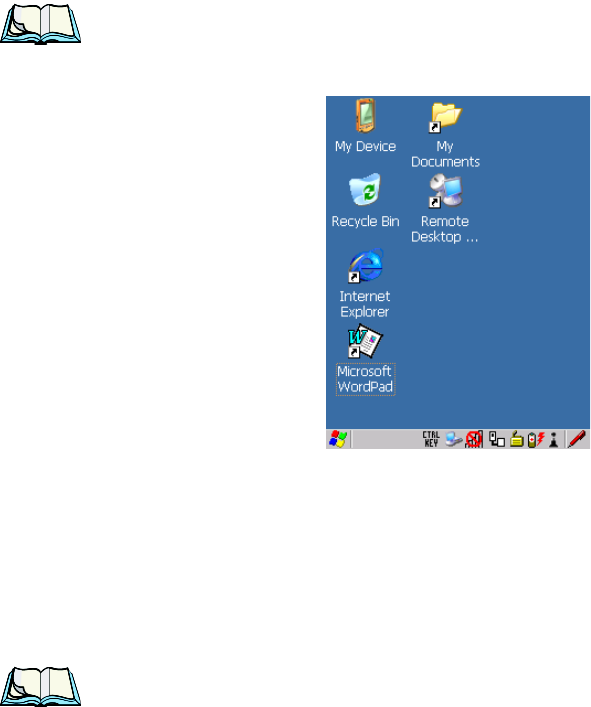
WORKABOUT PRO Hand-Held Computer With Windows CE 5.0 User Manual 57
Chapter 4: Working With Windows CE 5.0
The Startup Desktop
• Double-tap on the appropriate icon—either a folder icon, a program icon or
a file icon—to open or launch your selection.
If you’re using the keyboard:
• Use the arrow keys to highlight the icon you want to open or launch.
• Press [ENTER].
4.3 The Startup Desktop
When the WORKABOUT PRO boots up, the startup desktop (shell) is displayed.
Any applications stored in the Startup folder start up immediately.
Note: The startup folder is located in \Windows\StartUp and
\Flash Disk\StartUp.
Figure 4.2 The WORKABOUT PRO Startup Desktop
To access desktop icons:
• Double-tap on the icon to open a window or, in the case of an application
icon, launch an application.
On the keyboard:
• Use the arrow keys to highlight the icon, and press [ENTER] to launch the
highlighted icon.
Note: If the arrow keys do not highlight the desktop icons, the desktop may not
be selected. Press [FN/BLUE] [.] (period) to display the Start Menu, and
Chapter 4: Working With Windows CE 5.0
The Desktop Icons
58 WORKABOUT PRO Hand-Held Computer With Windows CE 5.0 User Manual
select Desktop. Now the desktop will be “in focus” and the arrow keys
will highlight the icons.
4.3.1 The Desktop Icons
The icons displayed in the startup desktop operate in much the same way as those
displayed on any standard PC desktop that is running Windows.
My Device
Choosing this icon displays the contents of your WORKABOUT PRO computer. If
you’re not sure how to access the files, folders and programs displayed, refer to
“Working With Files, Folders And Programs” on page 56.
Recycle Bin
This option temporarily stores items that were deleted, allowing you to either
permanently delete or restore these items.
Internet Explorer
Choosing this icon launches Internet Explorer—a standard Windows CE 5.0
version. Keep in mind that your supervisor will need to set up access using the
Internet Options and the Network and Dial-up Connections icons in the Control
Panel.
Remote Desktop Connection
This option allows your WORKABOUT PRO to communicate with a remote desktop
PC. “Remote Connect” on page 79 provides a website with step-by-step instructions.
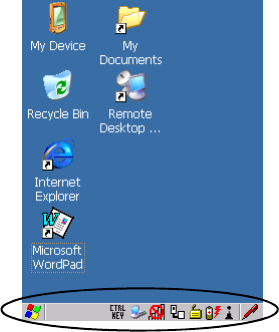
WORKABOUT PRO Hand-Held Computer With Windows CE 5.0 User Manual 59
Chapter 4: Working With Windows CE 5.0
The Taskbar
4.3.2 The Taskbar
Figure 4.3 The Taskbar
The WORKABOUT PRO is equipped with a taskbar at the bottom of the screen. It
displays icons through which you can view the battery capacity and radio signal
quality of your unit. If the hand-held is attached to a charger, cradle, docking station
or PDM, an associated icon is displayed. In addition, the taskbar displays the
application(s) currently running on your unit and the security level assigned to your
WORKABOUT PRO.
The taskbar also displays active modifier keys: [SHIFT], [ALT], [CTRL],
[FN/BLUE] and [FN/ORANGE]. Keys that have been locked “on” are displayed in
uppercase letters. For example, if you have set the [CTRL] key Lock to “on” in the
Keyboard menu and you press the key, it is displayed as CTRL KEY in the taskbar. (For
detailed information on modifier keys and keyboard options, see “The Keyboard”
on page 36).
4.3.2.1 Using The Taskbar
A tooltip is displayed as each taskbar icon is highlighted. The tooltip provides the
status of each icon.
If you’re using the touchscreen:
• Tap and hold the stylus on an icon to display the icon's tooltip. Double-tap
the icon to open the Control Panel dialog box associated with the icon. For
example, double-tap the battery icon to display a dialog box listing the
current battery capacity information.
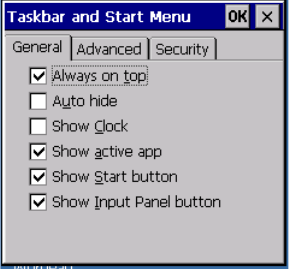
Chapter 4: Working With Windows CE 5.0
The Taskbar
60 WORKABOUT PRO Hand-Held Computer With Windows CE 5.0 User Manual
On the keyboard:
• Press [FN/BLUE] [.] (period) to display the Start Menu.
• Choose Shortcuts from the Start Menu, and then press the [RIGHT] arrow
key to display the sub-menu.
• Choose System Tray in the sub-menu.
• Use the arrow keys to highlight the icon in the taskbar about which you’d
like more information.
• Press [ENTER] to display the appropriate dialog box.
4.3.2.2 Customizing The Taskbar
To customize the taskbar so that it displays only those icons you require:
•In the Start Menu, choose Settings>Taskbar.
If you’re using the keyboard:
• Press [FN/BLUE] [0] (zero) to display the Start Menu.
• Highlight the Settings option, highlight Taskbar in the sub-menu, and
press [ENTER].
The Taskbar and Start Menu dialog box is displayed.
Taskbar General Tab
• Tap the stylus on the items you want to activate or deactivate. The check
mark indicates active items.
If you’re using the keyboard:
•Highlight the options you want to activate, and press the [SPACE] key to select
them. A check mark indicates active items.
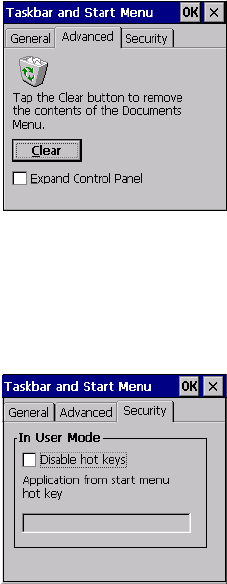
WORKABOUT PRO Hand-Held Computer With Windows CE 5.0 User Manual 61
Chapter 4: Working With Windows CE 5.0
The Taskbar
Taskbar Advanced Tab
• Tap on the Clear button to empty the Documents folder.
• To display Control Panel applets in menu form rather than in a window, tap
in the checkbox next to Expand Control Panel.
Taskbar Security Tab
If you check Disable hot keys, the Application from Start menu field becomes
enabled. Use this field to enter the name of the application you want to run when the
user presses the Menu hot key – [FN/BLUE] [0].
If you have disabled hot keys, hidden the Start Menu and have no application
configured, the Menu hot key brings up the Security dialog box to allow authorized
users to access the terminal configuration. Keep in mind that this dialog box is also
displayed if an invalid application is entered in the Application from Start Menu
field.
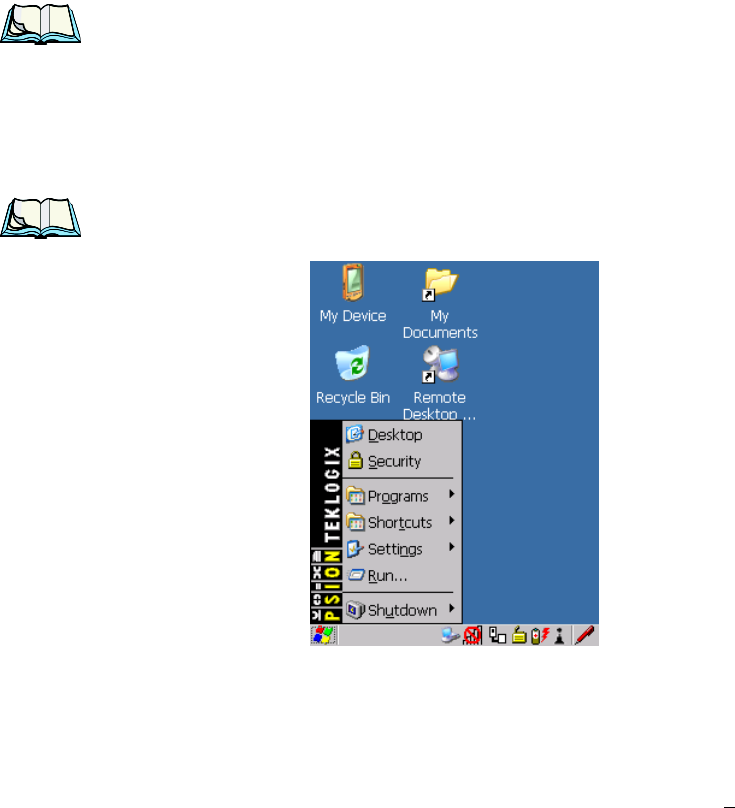
Chapter 4: Working With Windows CE 5.0
The Start Menu
62 WORKABOUT PRO Hand-Held Computer With Windows CE 5.0 User Manual
4.4 The Start Menu
Note: Some of the Start Menu items may be disabled based on the current
WORKABOUT PRO security settings.
The Start Menu lists the operations you can access and work with. It is available
from the startup desktop or from within any application.
To display the menu:
• Press [FN/BLUE] [.] (period).
Note: Tap on the item in the menu with which you want to work.
Figure 4.4 Start Menu
If you’re using the keyboard:
• Use the arrow keys to highlight a menu item, and press [ENTER], or
If the menu item has an underlined character:
• Type the underlined alpha character. For example, to display the Security
dialog box, type the letter ‘s’.
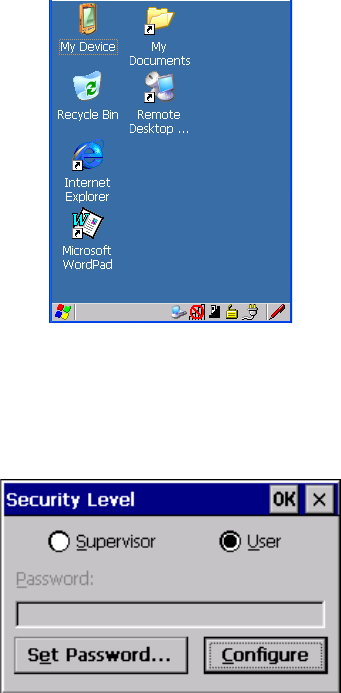
WORKABOUT PRO Hand-Held Computer With Windows CE 5.0 User Manual 63
Chapter 4: Working With Windows CE 5.0
The Desktop
4.4.1 The Desktop
Choosing Desktop in the Start Menu displays the WORKABOUT PRO desktop.
Figure 4.5 WORKABOUT PRO Desktop
4.4.2 Security Settings
Choosing the Security option from the Start Menu displays a dialog box in which
you can define the access level for the WORKABOUT PRO: Supervisor or User.
Figure 4.6 Security Levels
Assigning The Supervisor Security Level
The security level is represented by an icon in the shape of a lock in the taskbar. The
security levels define the options accessible to the operator in the Start Menu and
the taskbar. By default, the security level is set to User, restricting access to only the
most basic Start Menu items.
To allow access to all the Start Menu and taskbar options:
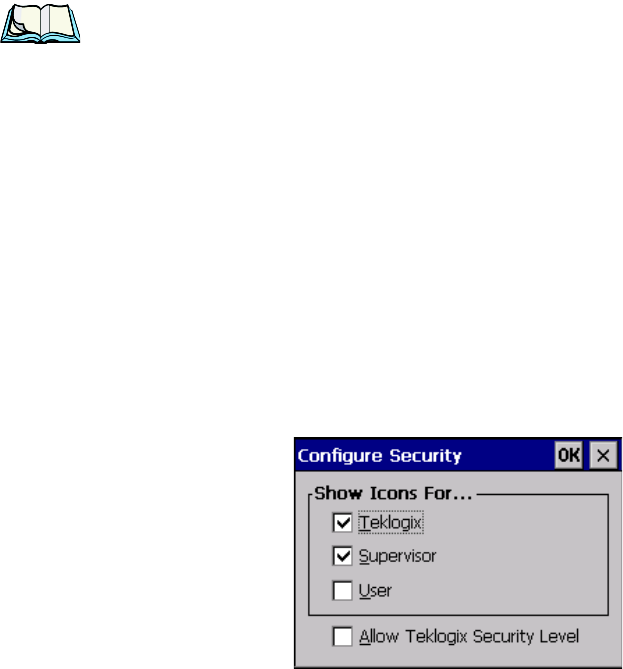
Chapter 4: Working With Windows CE 5.0
Security Settings
64 WORKABOUT PRO Hand-Held Computer With Windows CE 5.0 User Manual
•In the Security Level dialog box, tap on the radio button next to Supervisor.
•In the Password field, type the Supervisor level password. The default pass-
word is 123456.
• Tap on OK. You can now access all menu items in the Start Menu along
with the icons in the taskbar.
Changing A Password
Note: Keep in mind that this is the same password as that assigned through
the Password control panel applet. Refer to “Control Panel Icons” on
page 80.
To assign a password:
• Choose a security level, and enter the existing password in the Password
field.
• Tap on the Set Password button.
A dialog box labelled Password Properties is displayed.
• Type the new password in the Password: text box (all keyboard characters
are valid).
•In the Confirm Password: text box, retype the new password.
Configuring Security
Choosing the Configure button displays the Configure Security dialog box.
Figure 4.7 Configuring Security
This dialog box allows you to determine which security levels will have an
associated icon displayed in the taskbar. By default, a security icon is not displayed
for user-level security.
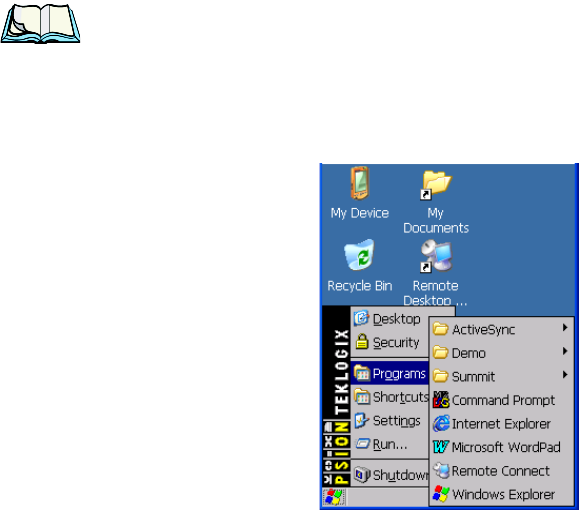
WORKABOUT PRO Hand-Held Computer With Windows CE 5.0 User Manual 65
Chapter 4: Working With Windows CE 5.0
Programs
Note: It is recommended that you enable ‘Allow Teklogix Security Level’ so that
authorized Psion Teklogix service personnel can access your unit should
it require maintenance.
4.4.3 Programs
• Choose Programs to display a sub-menu of options.
Figure 4.8 Program Sub-Menu
ActiveSync®
This option allows you to connect to another device using ActiveSync.
Demo
This folder contains the Demo Imager, Demo Scanner, and Demo Signature
applications. Demo Imager is used for simple image-capturing purposes and for
displaying bar code data and bar code statistics on the same screen with image data
and information. Demo Scanner can be used to test how the hand-held reads and
writes RFID tags. Demo Signature allows you to capture a signature written on the
screen with your stylus and save it to a file. Demo Sound allows you to record and
playback. The ‘Sample Rate’ and the ‘Bits Per Sample’ are the rates at which the
sound will be recorded. Sounds recorded at the higher sample rate or bits per sample
will be higher quality but will require more file space to store. Lower sample rates
and bits per sample or both the file result in a smaller file but the quality suffers. The
record and play buttons operate in the same way they do on any recording device.
the ‘X’ icon deletes the sound and the ‘diskette’ icon allows you to save your sound.
Chapter 4: Working With Windows CE 5.0
Programs
66 WORKABOUT PRO Hand-Held Computer With Windows CE 5.0 User Manual
Summit
This folder provides access to the Summit Client Utility (SCU), a utility that allows
you to configure your Summit 802.11b/g radio, model number RA2041.
Command Prompt
Command Prompt is used to access the DOS command prompt. At the prompt, you
can type DOS commands such as dir to display all the directories in the drive.
Internet Explorer
The WORKABOUT PRO is equipped with Microsoft Internet Explorer for
Windows CE 5.0. You can access the Internet Options icon through the Start Menu
under Settings, Control Panel or by double-tapping on the desktop Internet
Explorer icon.
Remote Connect
Remote Connect is a WORKABOUT PRO application used to connect to a
Windows Terminal Server so that you can run a “session” on the Server machine
using the WORKABOUT PRO (Windows CE 5.0 device). “Remote Connect” on
page 79 provides a website with details about this option.
Windows Explorer
The Windows Explorer installed on your WORKABOUT PRO is consistent with all
Windows CE 5.0 devices. You can access this option from the Start Menu under
Programs, Windows Explorer.
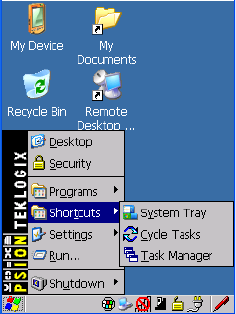
WORKABOUT PRO Hand-Held Computer With Windows CE 5.0 User Manual 67
Chapter 4: Working With Windows CE 5.0
Shortcuts
4.4.4 Shortcuts
Figure 4.9 Shortcuts Sub-Menu
System Tray
If your touchscreen is not enabled, you can use the System Tray option to access the
icons in the taskbar at the bottom of the screen. The taskbar displays indicators such
as a radio signal icon and the security level. These indicators are attached to dialog
boxes that provide additional information.
• Choose Shortcuts>System Tray.
Using the icons in the taskbar, you can either display the Control Panel dialog box
associated with an icon, or you can view a tooltip. A tooltip provides the status of
each icon.
• Tap and hold the stylus on an icon to display the icon’s tooltip. Double-tap
on the icon to open the Control Panel dialog box associated with the icon.
On the keyboard:
• Press [FN/BLUE] [0] to display the Start Menu.
• Choose Shortcuts from the Start Menu, and then press the [RIGHT] arrow
key to display the sub-menu.
• Choose System Tray in the sub-menu.
• Use the arrow keys to highlight the icon in the taskbar about which you’d
like more information. As each icon is highlighted, a tooltip is displayed.
• To display the associated Control Panel dialog box, press [ENTER].
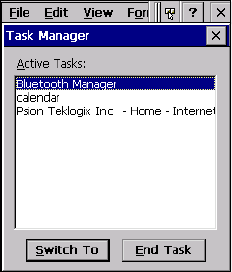
Chapter 4: Working With Windows CE 5.0
Shortcuts
68 WORKABOUT PRO Hand-Held Computer With Windows CE 5.0 User Manual
Cycle Tasks
When Cycle Tasks is selected (and the Task Manager is not open), you can cycle
through active applications.
To cycle through your active applications:
• Choose Shortcuts>Cycle Tasks, or
Press [ALT] [TAB].
Task Manager
The Task Manager allows you to switch to another task or to end an active task. To
display the task manager window:
• Tap on Shortcuts>Task Manager, or
Press [ALT] [ESC].
Figure 4.10 Task Manager
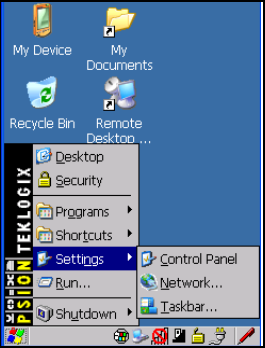
WORKABOUT PRO Hand-Held Computer With Windows CE 5.0 User Manual 69
Chapter 4: Working With Windows CE 5.0
Settings
4.4.5 Settings
The Settings sub-menu includes the following settings: Control Panel, Network
and Dial-up Connections and Taskbar and Start Menu.
Figure 4.11 Settings Sub-Menu
Control Panel
The Control Panel contains applets used to configure hardware, the operating
system and the shell. If your WORKABOUT PRO is running with the Psion
Teklogix TekTerm application or another application, additional configuration
applets may appear in the Control Panel.
Network And Dial-Up Connections
The Network and Dial-up Connections window allows you to configure the
WORKABOUT PRO radio or execute an existing configuration. Refer to
“Configuring The Summit RA2041 802.11b/g” on page 13 for radio setup details.
Taskbar And Start Menu
The Taskbar and Start Menu option displays a dialog box in which you can
customize the taskbar, choosing which options will be displayed. Refer to
“Customizing The Taskbar” on page 60 for additional details about this option.
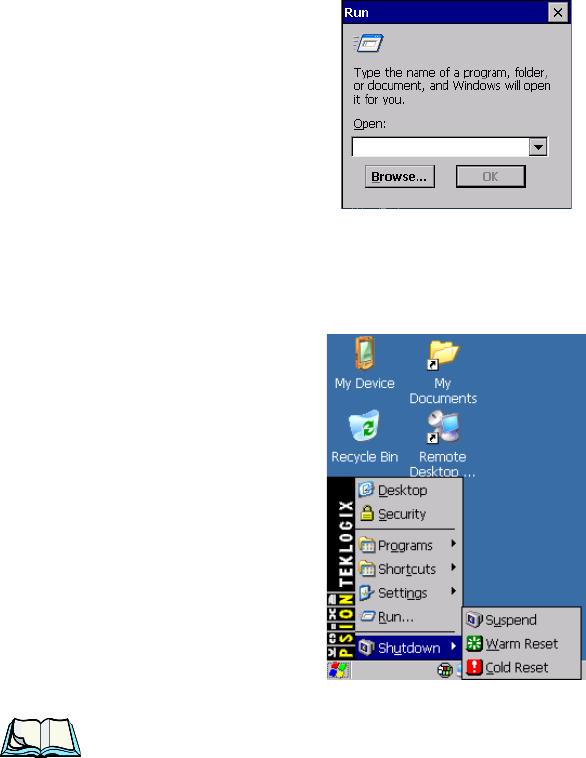
Chapter 4: Working With Windows CE 5.0
Run
70 WORKABOUT PRO Hand-Held Computer With Windows CE 5.0 User Manual
4.4.6 Run
Choosing the Run option from the Start Menu displays a dialog box in which you
can enter the name of the program, folder or document you want to open or launch.
Figure 4.12 Run Dialog Box
4.4.7 Shutdown
The Shutdown menu includes these options: Suspend, Warm Reset and Cold Reset.
Figure 4.13 Shutdown Sub-Menu
Note: This menu varies slightly depending on the security level chosen. When
the WORKABOUT PRO is set to User level, the Shutdown option is
replaced by Suspend. A sub-menu is not available.
Suspend
The Suspend option suspends the WORKABOUT PRO immediately. This is
equivalent to turning the hand-held off.
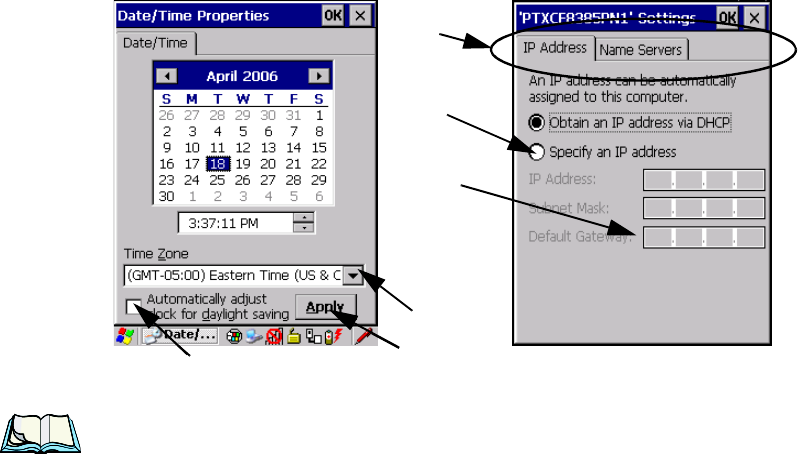
WORKABOUT PRO Hand-Held Computer With Windows CE 5.0 User Manual 71
Chapter 4: Working With Windows CE 5.0
Using A Dialog Box
Warm Reset
The Warm Reset option resets the WORKABOUT PRO, leaving all saved files and
(registry) settings intact. Any unsaved data is lost.
Cold Reset
The Cold Reset option resets the WORKABOUT PRO (see page 26). Any files not
stored in permanent memory are lost; however, the registry settings are saved.
4.5 Using A Dialog Box
A dialog box (like the samples in Figure 4.14) appears when you need to make
selections and enter further information. You can move between dialog items by
tapping on them with your stylus, or by pressing the arrow keys and the [TAB] key
([SHIFT] [TAB] moves the cursor backwards).
Figure 4.14 Dialog Boxes
Note: You can use the stylus to tap on an element in a dialog box to select or
deselect it, display drop-down menus, save your selections, and so on.
Dialog boxes contain one or more of the following elements:
Tab: A tab separates different elements of a dialog box. Press the [TAB] key until a
tab in the dialog box is highlighted. To display adjoining tabs, press the [RIGHT] or
[LEFT] arrow key. To display the information in the next tab from anywhere in the
window, press [CTRL] [TAB].
Checkbox
Drop-down Menu
Button
Textbox
Radio
Button
Tabs

Chapter 4: Working With Windows CE 5.0
Using A Dialog Box
72 WORKABOUT PRO Hand-Held Computer With Windows CE 5.0 User Manual
Tex tbox: A textbox requires that you type information. Press the [TAB] key to
highlight the textbox and then type the appropriate information.
Drop-down: This type of menu is identified by up and down arrows next to the
drop-down menu to indicate that additional options are available. Press the [TAB]
key to highlight the menu, and use the arrow keys on your keyboard to cycle
through the options.
Checkbox: This box allows you to select or deselect an option. To select or deselect
a checkbox, press the [TAB] key to highlight the checkbox, and press the [SPACE]
key to select or deselect it.
Radio buttons: These buttons allow you to choose from a number of options. For
example, in the sample screen in Figure 4.14 on page 71 you can choose to Obtain
an IP address via DHCP or Specify an IP address. Press the [TAB] key to highlight
a radio button option, and then select a radio button by pressing the arrow keys to
highlight the appropriate option.
Buttons: This type of button allows you to Save, Delete and so on the options
you’ve chosen in a dialog box. Use the [TAB] key to highlight the button you want
to use. Press the [ENTER] key to activate it.
Saving Your Choices: Once you’ve made all your changes, press the [ENTER] key
to save your changes and exit the window.
Note: A dialog box item that is displayed in grey text indicates that it is not cur-
rently available.

WORKABOUT PRO Hand-Held Computer With Windows CE 5.0 User Manual 73
CONFIGURATION 5
5.1 Remote Connect...............................79
5.2 The TekTerm Application..........................79
5.3 The Control Panel..............................79
5.4 Control Panel Icons.............................80
5.5 Basic Setup.................................84
5.5.1 Display Properties ..........................84
5.5.1.1 Display Backlight......................85
5.5.1.2 Display Appearance.....................86
5.5.2 Keyboard Properties . . . . . . . . . . . . . . . . . . . . . . . . . 87
5.5.2.1 Key Repeat..........................87
5.5.2.2 Keyboard Backlight.....................88
5.5.2.3 Keyboard One Shot Modes.................89
5.5.2.4 Keyboard Macro Keys....................90
5.5.2.5 Unicode Mapping......................92
5.5.2.6 Scancode Remapping....................93
5.5.3 Volume And Sound Properties . . . . . . . . . . . . . . . . . . . . 96
5.5.3.1 Volume Adjustments.....................97
5.5.3.2 Sound Adjustments . . . . . . . . . . . . . . . . . . . . . 97
5.5.4 Power Management Properties....................98
5.5.4.1 Battery Capacity.......................98
5.5.4.2 Power Saving Suspend....................99
5.5.4.3 Suspend Threshold......................100
5.5.4.4 Advanced ..........................101
5.5.4.5 Devices............................102
5.5.4.6 Wakeup ...........................102
5.5.5 Stylus Properties...........................103
5.5.5.1 Double-Tap . . . . . . . . . . . . . . . . . . . . . . . . .103
5.5.5.2 Calibration..........................103
5.5.5.3 Touch ............................104
5.5.6 Manage Triggers...........................104
5.5.6.1 Trigger Mappings......................105
5.5.6.2 Add And Edit Trigger Mapping . . . . . . . . . . . . . . .106
5.5.7 Certificate Assignment........................108
Chapter 5: Configuration
74 WORKABOUT PRO Hand-Held Computer With Windows CE 5.0 User Manual
5.6 Bluetooth Setup..............................109
5.6.1 The Devices Tab........................... 110
5.6.1.1 Pairing A Device...................... 111
5.6.2 The Servers Tab........................... 114
5.6.3 Outgoing Tab............................ 115
5.6.4 Active Conn. Tab.......................... 116
5.6.5 The Properties Tab ......................... 117
5.6.6 The Bluetooth GPRS WAN Connection . . . . . . . . . . . . . . 117
5.7 Total Recall................................123
5.7.1 Creating A Backup Profile . . . . . . . . . . . . . . . . . . . . . 124
5.7.2 Restoring A Profile.........................128
5.8 The Storage Manager...........................128
5.8.1 Formatting A Memory Card.................128
5.8.2 Creating Partitions......................129
5.8.3 Partition Management....................131
5.9 IPv6 Support................................133
5.10 Scanner Settings.............................134
5.10.1 Bar Codes.............................135
5.10.1.1 Scanner..........................135
5.10.1.2 Restoring Default Settings . . . . . . . . . . . . . . . . 135
5.10.2 Decoded (Internal) Scanners....................137
5.10.2.1 Options..........................137
5.10.2.2 Decoded (Internal) Advanced Options . . . . . . . . . . 138
5.10.2.3 Decoded (Internal) 2D Scanning Options . . . . . . . . 139
5.10.2.4 Decoded (Internal) Data Options . . . . . . . . . . . . . 140
5.10.2.5 Code 39..........................141
5.10.2.6 Code 128.........................144
5.10.2.7 EAN 13..........................144
5.10.2.8 EAN 8...........................145
5.10.2.9 UPC A ..........................145
5.10.2.10 UPC E..........................146
5.10.2.11 UPC/EAN Shared Settings ...............147
5.10.2.12 Code 93.........................148
5.10.2.13 Codabar.........................149
5.10.2.14 MSI Plessey.......................149
5.10.2.15 Interleaved 2 of 5....................150
5.10.2.16 Discrete 2 of 5......................151
5.10.2.17 RSS Code........................152
WORKABOUT PRO Hand-Held Computer With Windows CE 5.0 User Manual 75
Chapter 5: Configuration
5.10.2.18 Composite.........................152
5.10.2.19 PDF-417..........................153
5.10.2.20 Micro PDF-417......................153
5.10.3 Decoded (HHP)...........................154
5.10.3.1 Decoded (HHP) Scanner Options . . . . . . . . . . . . .154
5.10.3.2 Decoded (HHP) Advanced Options . . . . . . . . . . . .154
5.10.3.3 Code 39...........................155
5.10.3.4 Trioptic Code........................156
5.10.3.5 Code 128..........................156
5.10.3.6 EAN 13 Settings......................157
5.10.3.7 EAN 8 ...........................158
5.10.3.8 UPC A Settings.......................158
5.10.3.9 UPC E Settings.......................159
5.10.3.10 UPC/EAN Shared Settings................160
5.10.3.11 Code 93..........................160
5.10.3.12 Codabar..........................161
5.10.3.13 MSI Plessey........................162
5.10.3.14 Code 11..........................163
5.10.3.15 Interleaved 2 of 5.....................163
5.10.3.16 Matrix 2 of 5 .......................164
5.10.3.17 IATA 2 of 5........................164
5.10.3.18 Discrete 2 of 5.......................165
5.10.3.19 Telepen..........................165
5.10.3.20 RSS Code (Reduced Space Symbology) . . . . . . . . .166
5.10.3.21 PosiCode (Reduced Space Symbology) . . . . . . . . .167
5.10.3.22 Composite.........................167
5.10.3.23 TLC-39..........................168
5.10.3.24 PDF-417..........................168
5.10.3.25 Micro PDF-417......................169
5.10.3.26 Code 16K.........................169
5.10.3.27 Code 49..........................170
5.10.3.28 Codablock.........................170
5.10.3.29 2D Data Matrix......................170
5.10.3.30 2D QR Code........................171
5.10.3.31 2D Maxicode.......................171
5.10.3.32 2D Aztec .........................172
5.10.3.33 Postal: PlaNET......................172
5.10.3.34 Postal: PostNET......................172